Tag: Primer
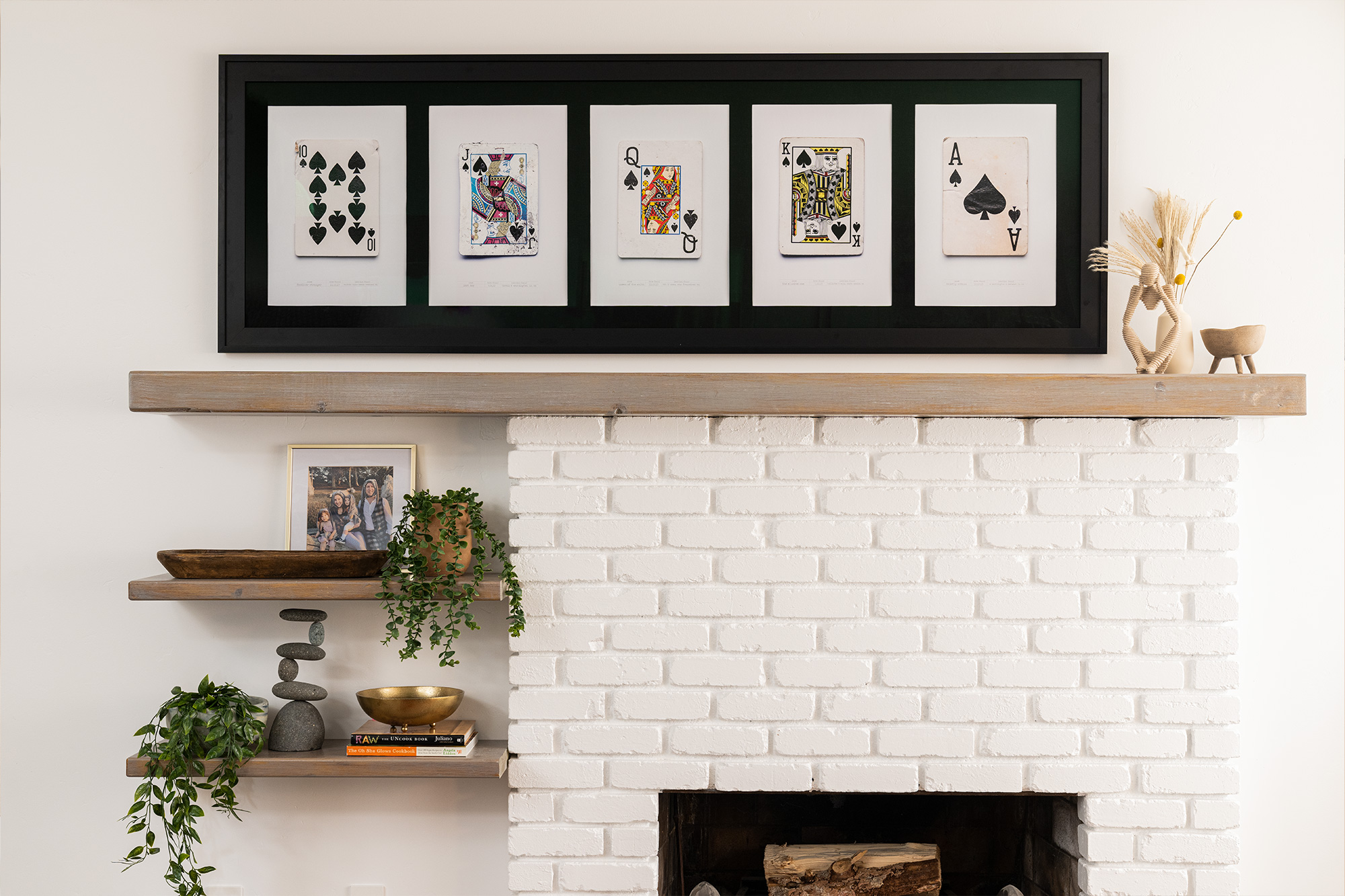
An Outdated Living Room Gets a Facelift
April 17, 2023On this episode of Destination Restoration, we upgraded an open concept family living/dining room, while demonstrating the power of primer in a striking fireplace restoration. Rather than putting this 4th generation home through a full gut rehab, our pros, Jason Lai (interior designer) and Jared Foster (contractor/pro painter) worked to reimagine the space and rejuvenate it for another generation. This series demonstrates how you can breathe new life into an older home while keeping its structural integrity intact.
Jason and Jared worked together to take this space from ordinary to inviting, contemporary, and cheerful with a few tweaks. Keeping in mind aesthetics and functionality, the goal was to avoid tearing things out and starting from scratch, and instead, add value to the existing room. They updated the décor, primed, and painted the fireplace, added new lighting, built a convenient storage unit in the dining area, and overall, made the space look chic and feel cozy.
We’ve broken down each area below so you can get a more detailed look into the upgrades we made. If you’re not sure where to start, we’ve included a step-by-step guide of how to paint brick fireplaces like the one here.
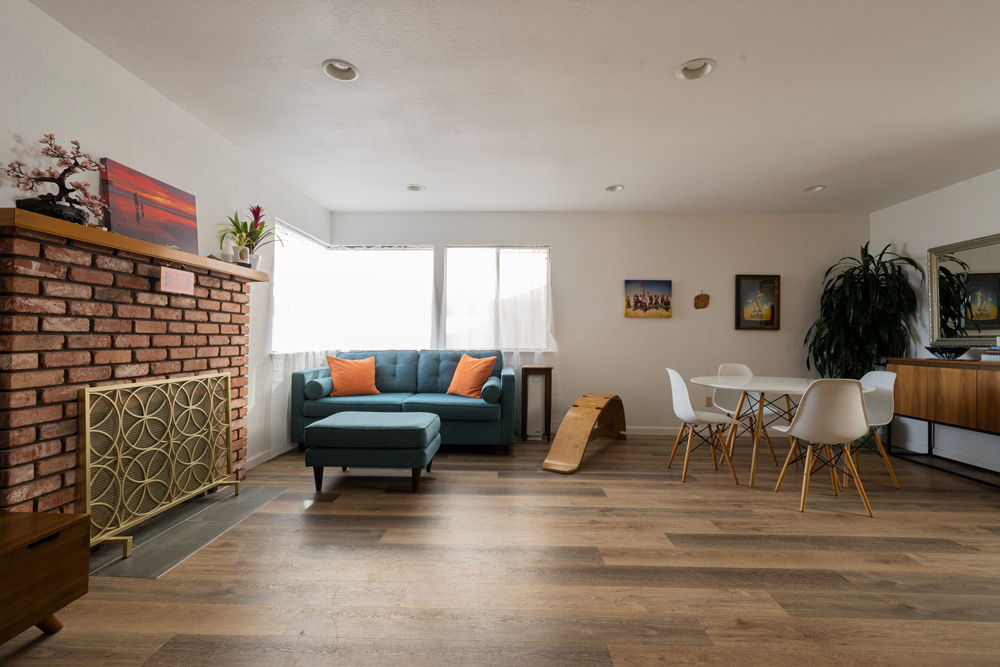
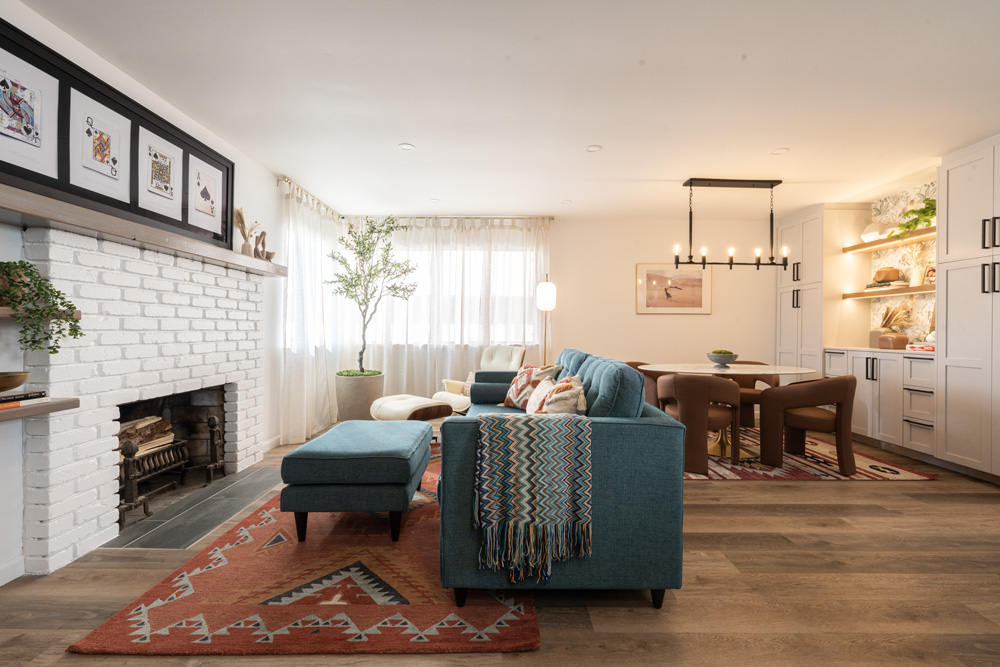
Living Area
First, we primed the fireplace and front door using KILZ 2® All-Purpose Primer. For living room paint colors, the front door was painted Chic Grey and the fireplace Whipped Cream, both colors by Behr Paint. We also replaced the front door hardware for a more modern look. Using the beam we removed from the kitchen ceiling, we stained and repurposed it to extend the mantle out to the left of the fireplace. Finally, we added floating shelves just underneath. These shelves were the result of leftover pieces from the kitchen beam, which were also stained to match.
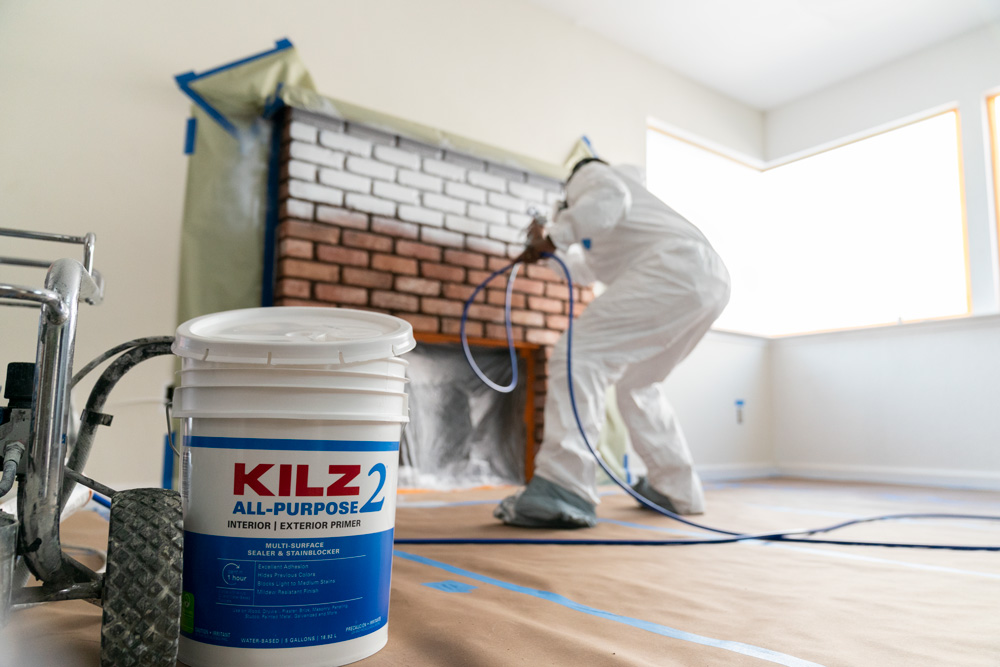
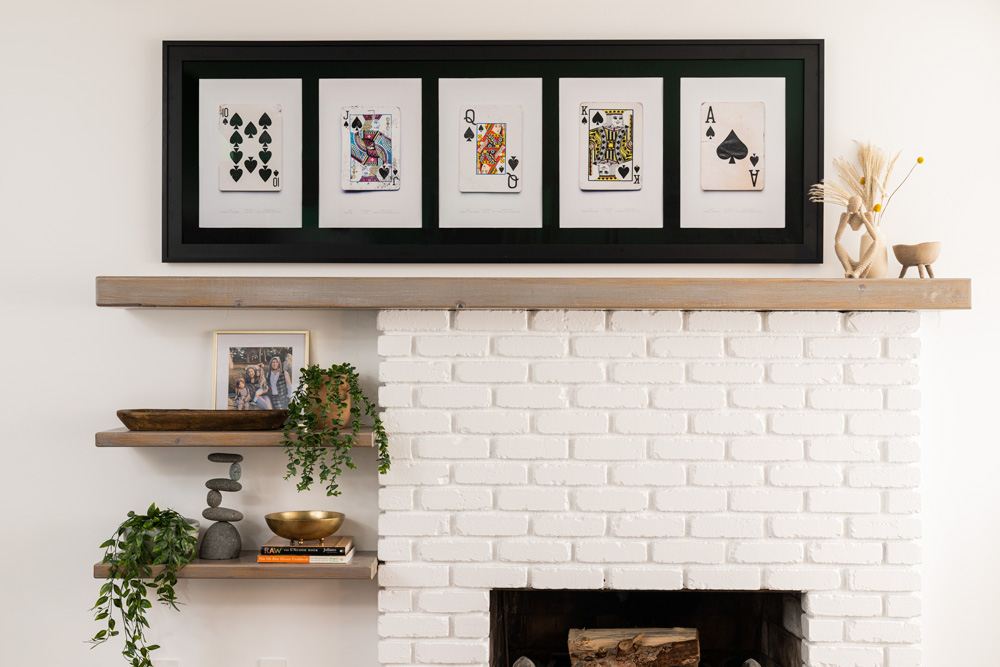
Dining Area
To spruce up the old dining area, we replaced the buffet cabinet with a larger, built-in storage unit, and brightened it up with under cabinet lighting and a linear chandelier (by Kichler Lighting) over the dining table.
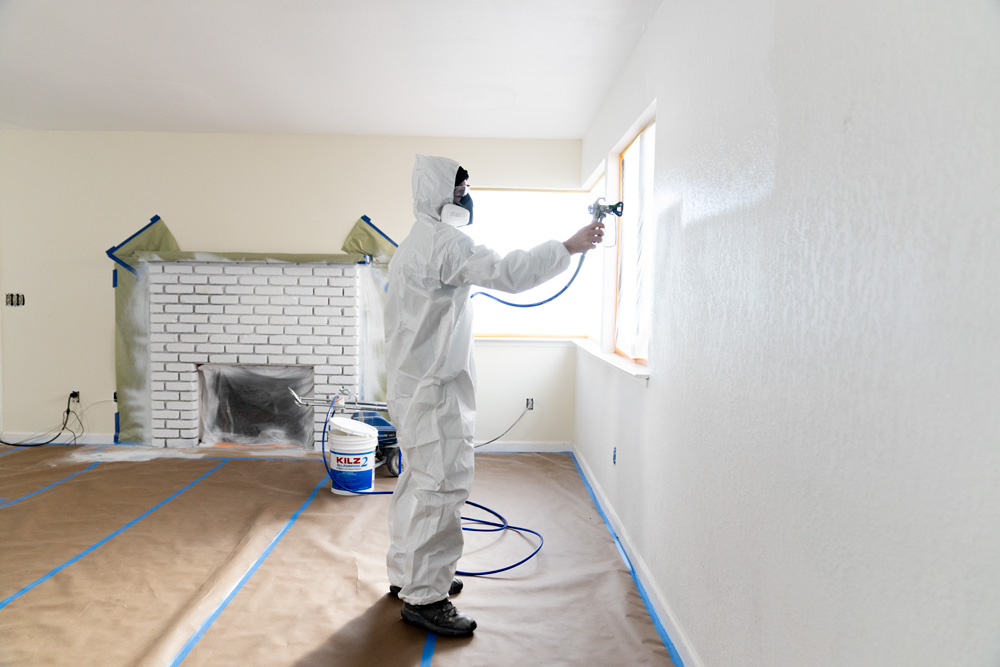
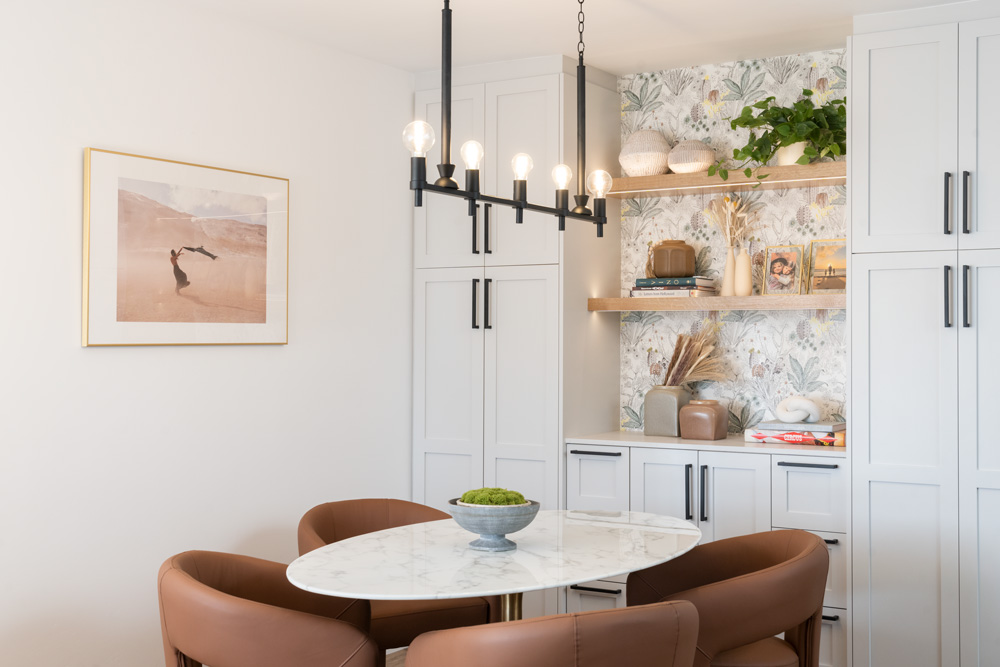
Other Changes
Our interior designer, Jason, added touches of new furniture and décor throughout this space to bring it into the modern day. He chose to keep the existing couch and update the throw pillows and blanket, as well as rearrange the furniture to create a distinct living and dining area within the space.
Why Do You Need to Prime?
Priming is essential for proper surface preparation for any paint project. It’s the difference between a job done and a job done right. Priming helps solve a wide range of problems, including highly porous surfaces, stains, odors, uneven surfaces, texture differences, and adhesion problems.
For the purposes of this project we used, KILZ 2® All-Purpose Primer because it dries fast and can be used on many surfaces, including brick. It’s also a great stain blocker with excellent adhesion, mildew resistance, sealing properties and a very mild odor. Its enhanced hiding formula makes it ideal for changing colors, like in the case of our fireplace, and helps lessen the number of coats of paint required, saving you time and money.
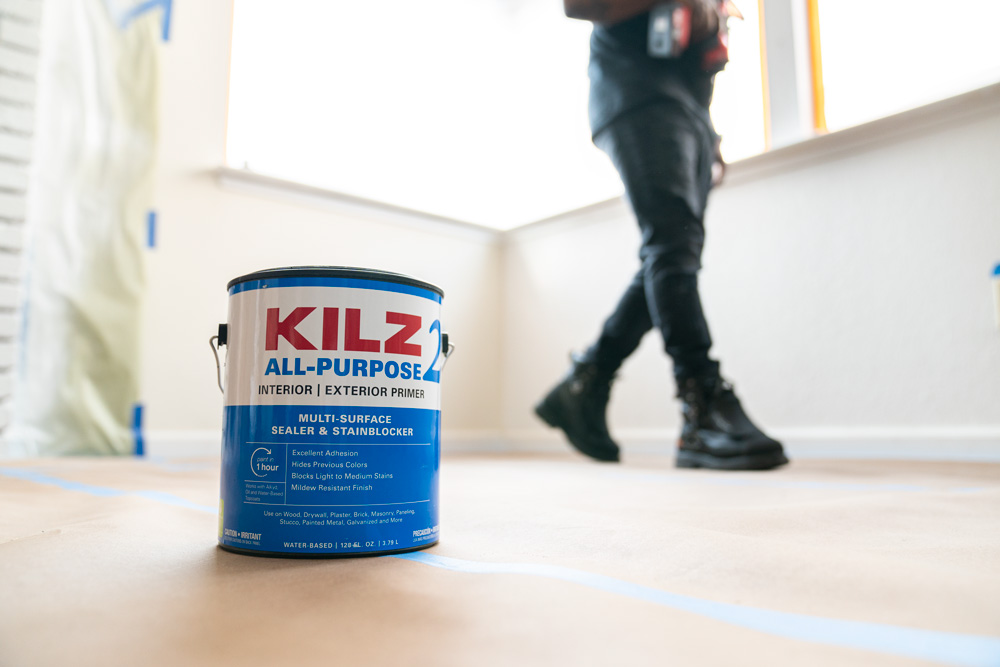
Step-By-Step Guide for a Brick Fireplace Makeover:
A primed and painted fireplace requires a few basic steps from start to finish. Here’s an easy guide to follow for your next project:
1. Clean the bricks. If it’s extra dirty, start with a vacuum and use the crevice tool attachment to clean between the bricks. Next, wipe down the fireplace with a damp cloth to ensure all surfaces are clean and free of any lingering dust. Allow to dry.
2. Tape around the fireplace to protect the walls and floor. Also tape around the mantel and where the brick meets the firebox (the inside where the wood goes!) to keep that area protected from paint and primer.
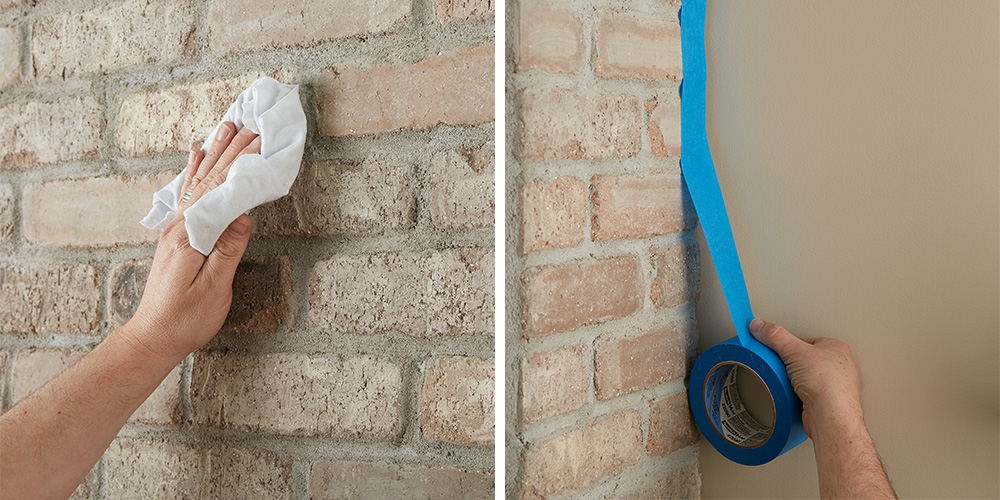
3. Protect your floors from paint and primer by covering it with a drop cloth.
4. Now it’s time to prime! Using KILZ 2® All-Purpose Primer, start with an angled brush to cut in around the mantle and edges of the fireplace.
5. Next, use a roller to cover the brick faces with primer.
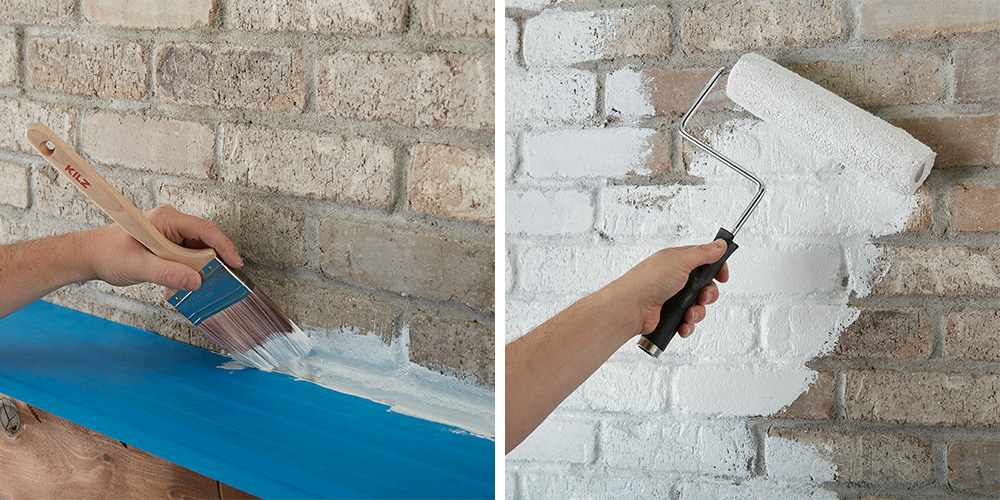
6. Go back with a small, angled brush to fill in any remaining grout areas and crevices in the bricks.
7. Allow to dry for 1 hour.
8. Once the primer is dry, apply paint of your choice using the same application process at the primer.
9. Remove the painter’s tape before your paint is fully dry.
You Will Need:
• Vacuum and rags to wipe dirty and dusty surfaces
• Painter’s tape
• Drop cloths, canvas, or other reusable material
• Paint roller, angled brush, and paint tray
• Paint of choice
We hope this episode of Destination Restoration inspires you to tackle your own living room remodel this year. Be sure to keep KILZ® products in mind for your next project, and come back for more ideas, tips, and project inspiration.
If you loved this restoration, be sure to check out the other episodes of Destination Restoration. Jason and Jared took on the Kitchen, Primary Bedroom and Primary Bathroom.
Always remember to refer to our website kilz.com or product back labels for additional information on which primer is right for your project and detailed instructions on how to apply our products. Check out our Coverage Calculator to understand your estimated paint needs for your upcoming project.
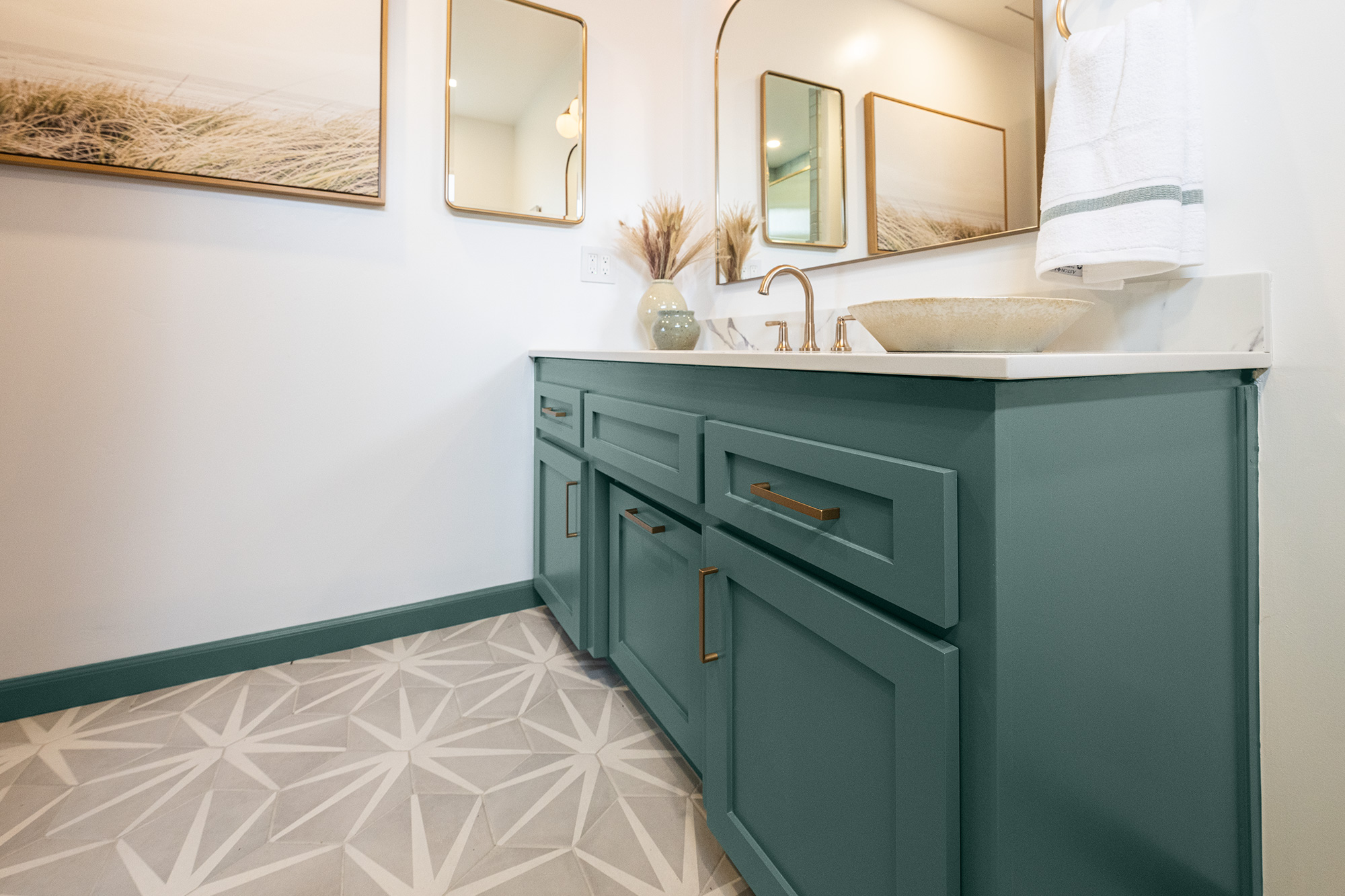
Bringing a Primary Bathroom Back to Life
April 17, 2023In this episode of our Destination Restoration series, we show you how to update a primary bathroom past its prime. This bathroom, like the rest of the rooms in this house, was outdated, dark, and in need of some attention. But, with a few cosmetic fixes, our pros, Jason Lai (interior designer) and Jared Foster (contractor/professional painter) transformed this room into something truly special.
This series demonstrates how you can breathe new life into an older home (in this case, a 4th generation family home), while keeping its structural integrity intact.
Just off the primary bedroom, the small, 4-piece primary bathroom was in desperate need of a facelift. Like a kitchen, there are many elements to consider in a bathroom, including hardware, tile, glass, and lighting. Not to mention a color scheme and décor. Using KILZ® Mold & Mildew Primer, we were able to restore the existing vanity and give it a fresh topcoat. We also replaced the tile and countertop, updated the walk-in shower, and painted the walls for a fresh new look that complemented the rest of the home.
While the bathroom is a smaller room compared to the others in your home, that doesn’t make it any less of a project. All it takes is a great concept and a team who knows how to execute, and you can bring any bathroom up to date in no time. For some bathroom inspiration, see the breakdown of our project in more detail below. We’ve also included a step-by-step guide on how to paint bathroom cabinets.
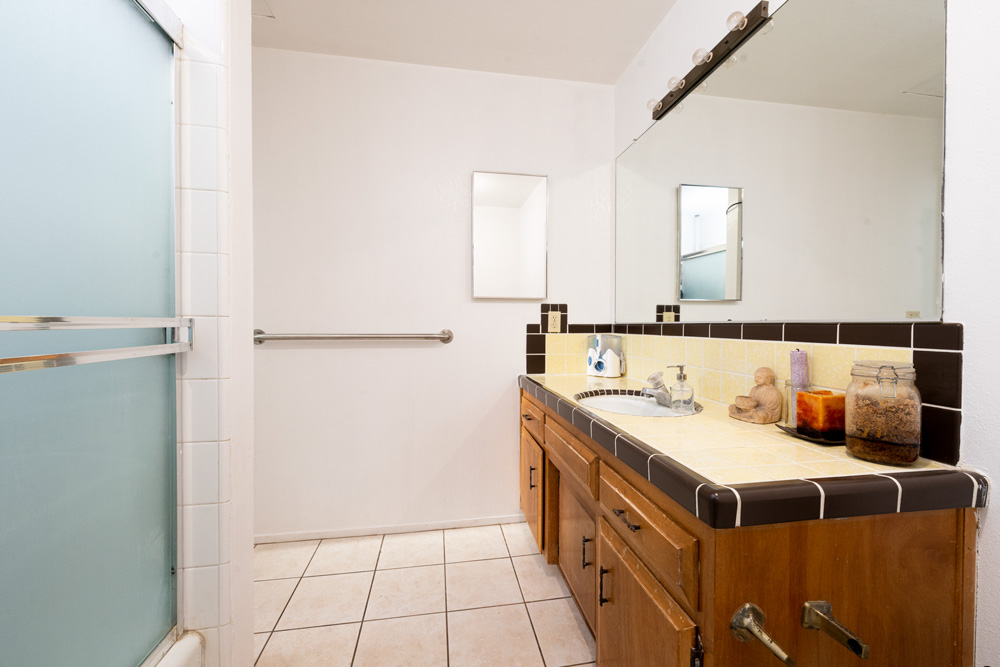
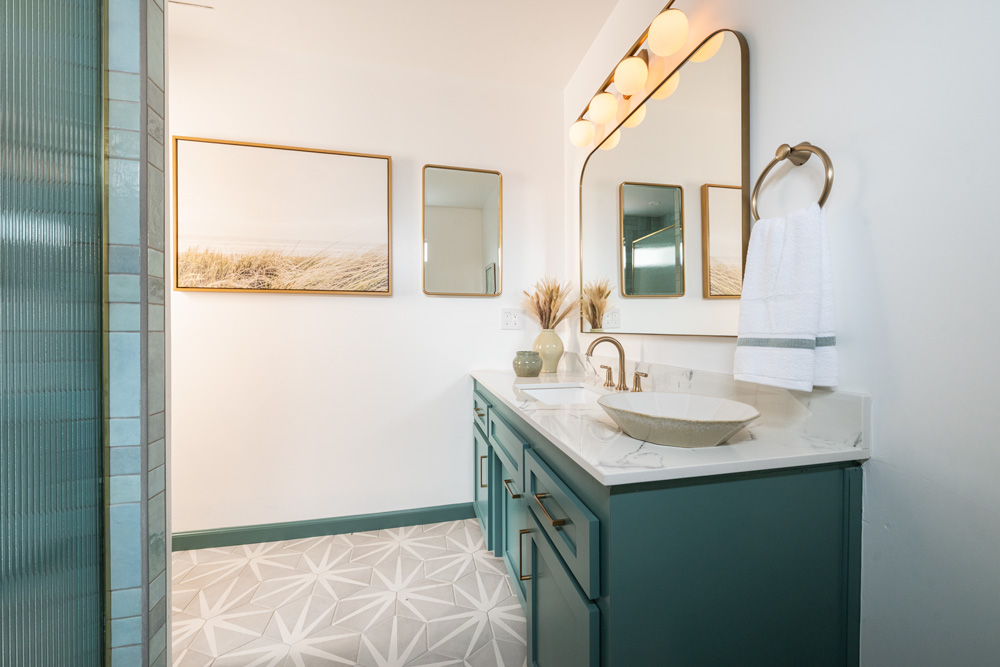
Vanity, Cabinets & Walls
To start, we primed the vanity using KILZ® Mold & Mildew Primer and painted it with Aspen Valley, a color by Behr Paint, for a teal effect that tied in well with other areas of the home. We also updated the cabinets to shaker style to mimic the update we made to the kitchen cabinets. For the other bathroom paint colors, we painted the walls, ceiling, and door with Whipped Cream, a color by Behr.
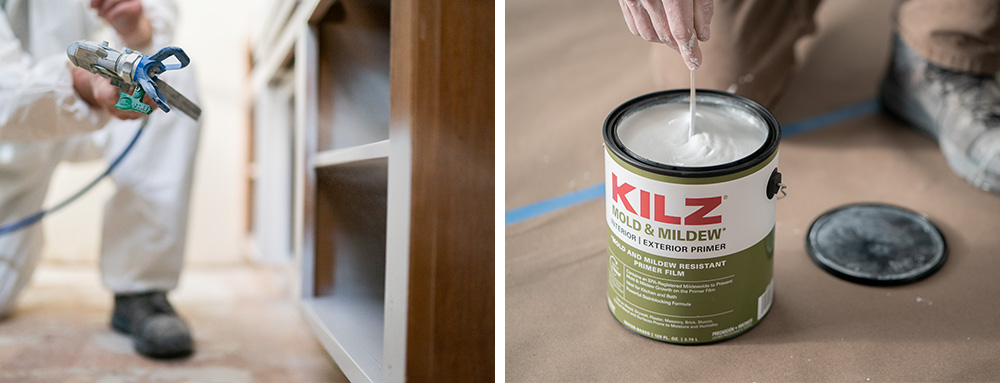
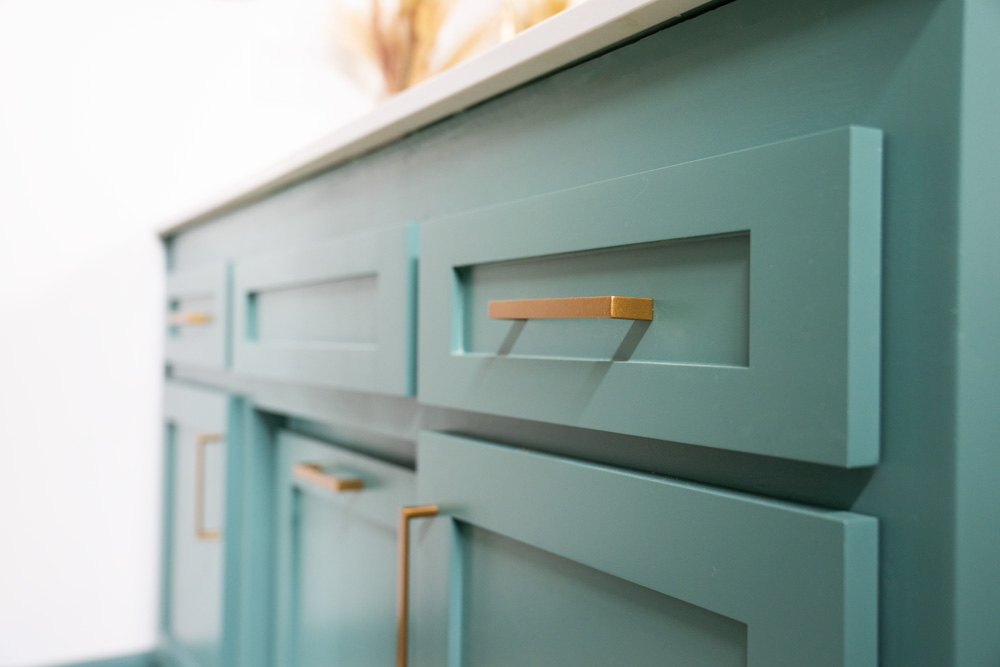
Shower & Hardware
We replaced the bathtub with a sleek walk-in shower, which we also retiled using a multicolored eggshell tile to contrast with the teal of the vanity. Lastly, we installed all new fixtures by Delta Faucet.
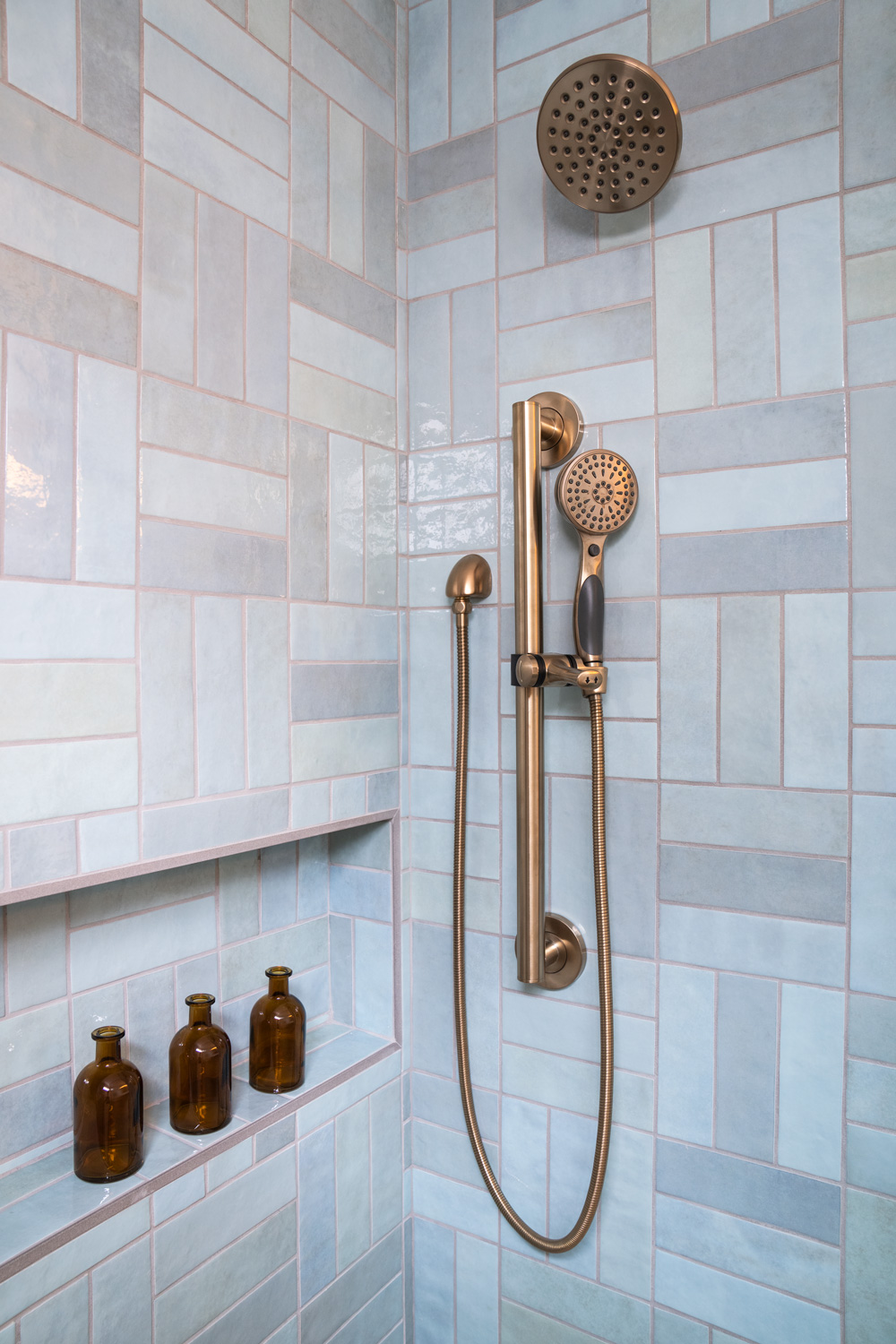
Other Changes
The floor was old and dingy, so we replaced it with an updated, geometric pattern tile—a fun detail that tied in well with the rest of the décor—and we added new overhead lighting and sconces by Kichler Lighting.
Why Do You Need to Prime?
Priming is essential for proper surface preparation for any paint project. It’s the difference between a job done and a job done right. Priming helps solve a wide range of problems, including highly porous surfaces, stains, odors, uneven surfaces, texture differences, and adhesion problems.
KILZ® Mold & Mildew Primer is a water-based primer-sealer-stain blocker, specially designed for residential surfaces in high humidity, moisture, and temperature environments, and a perfect choice for our bathroom makeover. It offers excellent adhesion, while providing a sound anchor for paints. The EPA registered active ingredient creates a mold and mildew-resistant film that protects the primer film from mold and mildew growth, so you can enjoy your newly-restored bathroom for years to come.
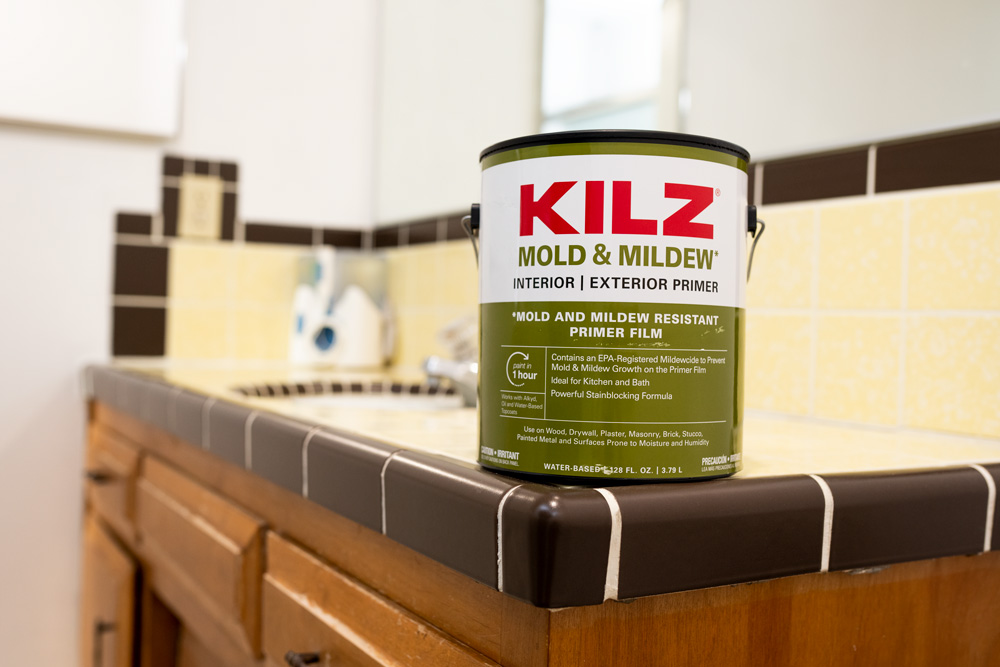
Step-By-Step Guide To Painting Bathroom Cabinets:
Refinishing a bathroom vanity requires a few basic steps to get the smoothest finish and results that will last in a humid environment. Here’s an easy guide to follow for your next project:
1. Use a screwdriver to remove the cabinet doors and drawers from the vanity and to remove all door handles and hardware.
2. Sand the surfaces of the doors, drawer faces, and vanity to create a smooth surface for priming. Do a first pass with 100-150 grit sandpaper then finish with a second pass of 180-220 grit sandpaper. Remember, the higher the “grit” number, the smoother the finish.
3. When sanding, move the sandpaper in the same direction as the wood grain. If you go against the grain, you will end up with a lot of scratches that will show through your topcoat.
4. After sanding, wipe down the surface with a damp cloth to remove any dust or residue. Allow to dry.
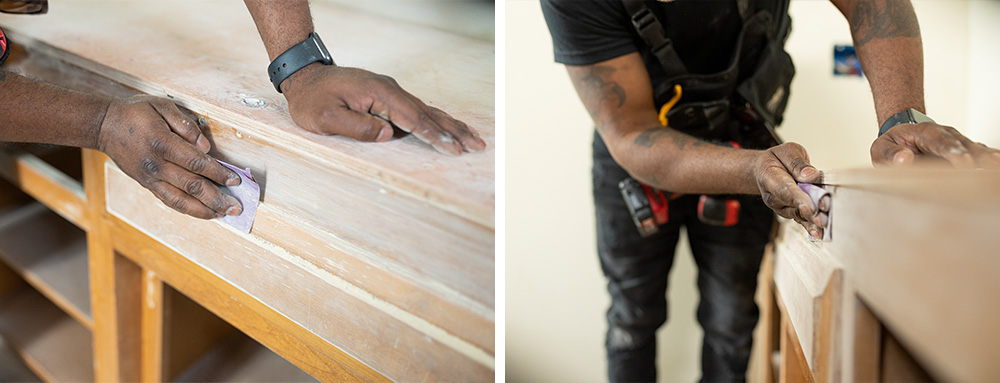
5. Protect your floors and workspace from paint and primer by covering it with a drop cloth.
6. For mildew-prone areas like a bathroom, select a primer formulated for high humidity, moisture, and temperature environments like KILZ® Mold & Mildew Primer.
7. Now it’s time to prime! Using your primer, use a brush to make smooth strokes that go in the same direction as the wood grain.
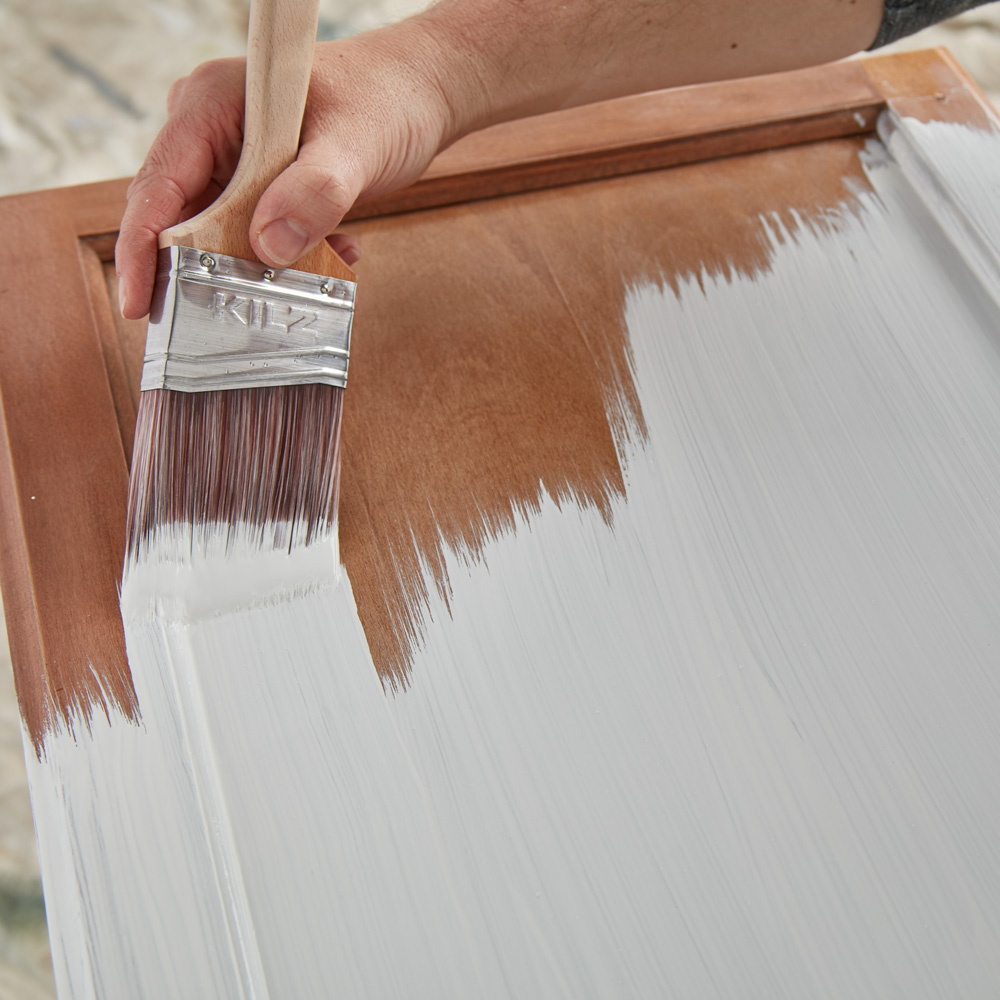
8. Allow to dry for 2 hours.
9. Once the primer is dry, apply paint of your choice using the same application process at the primer.
• Pro-tip: For a really great result, apply primer and paint with a sprayer.
10. Once your paint is dry, reattach hardware to doors, and then reattach the doors to the vanity.
You Will Need:
• Screwdriver
• Dust mask
• 100-150 grit and 180-220 grit sandpaper
• Rags to wipe dirty and dusty surfaces
• Drop cloths, canvas, or other reusable material
• Paint roller, brush, and paint tray
• Paint of choice
We hope this episode of Destination Restoration inspires you to tackle your own bathroom remodel this year. Be sure to keep KILZ® products in mind for your next project, and come back for more ideas, tips, and project inspiration.
If you loved this restoration, be sure to check out the other episodes of Destination Restoration. Jason and Jared took on the Kitchen, Primary Bedroom and Living/Dining Room.
Always remember to refer to our website kilz.com or product back labels for additional information on which primer is right for your project and detailed instructions on how to apply our products. Check out our Coverage Calculator to understand your estimated paint needs for your upcoming project.
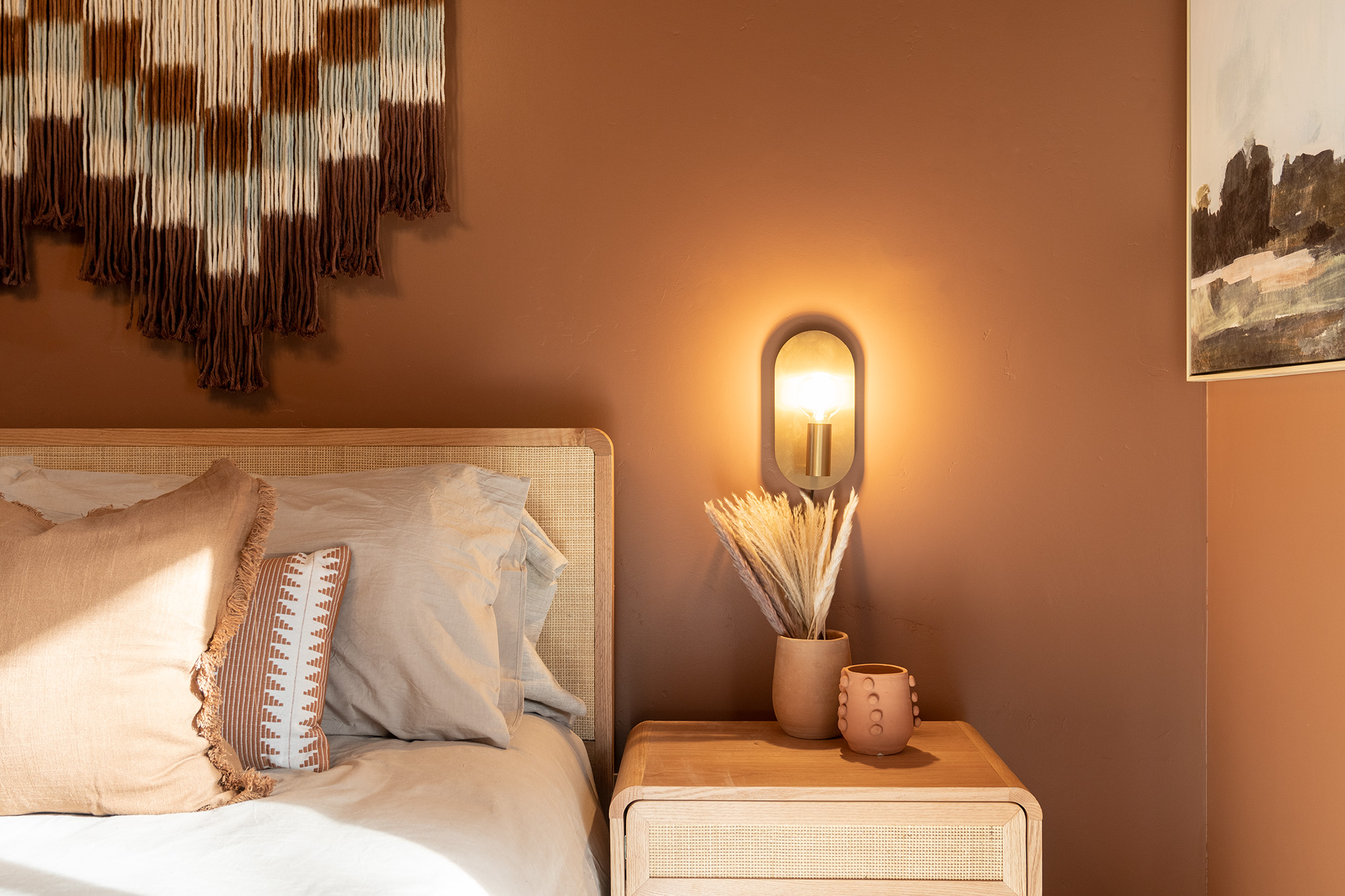
From Stained to Stunning: Restoring a Primary Bedroom
April 17, 2023On this episode of Destination Restoration, we show you how to restore a room that’s suffered a bit of damage. Older generational homes can accumulate imperfections over time, especially stains from things like water damage. In the case of today’s refresh, not only do we take a standard primary bedroom and update it for a new era, but we also tackle how to restore unsightly, odorous stains using primer and a fresh coat of paint.
This series demonstrates how you can breathe new life into an older home (in this case, a 4th generation family home), while keeping its structural integrity intact.
Once again, our fabulous design duo—Jason Lai (interior designer) and Jared Foster (contractor/pro painter) —found a way to update this modest room while addressing the large yellow stain that had leaked its way around the sliding glass door. Our goal was to both cover it up and ensure it wouldn’t show through, which we achieved with a thorough coat of primer and a new coat of paint. Due to the lack of storage in the room, we also wanted to install a custom unit, with ample cabinets to make the space more functional and a modern haven for the parents of this lovely family home.
Covering up stains takes a little extra effort but is totally doable with the right tools. Make sure you choose a sturdy primer that’s right for the job, like KILZ RESTORATION® Interior Primer when tackling a similar project of your own, and follow along to see how our pros approached this room makeover. We’ve also included a step-by-step guide on how to paint over water stains using primer.
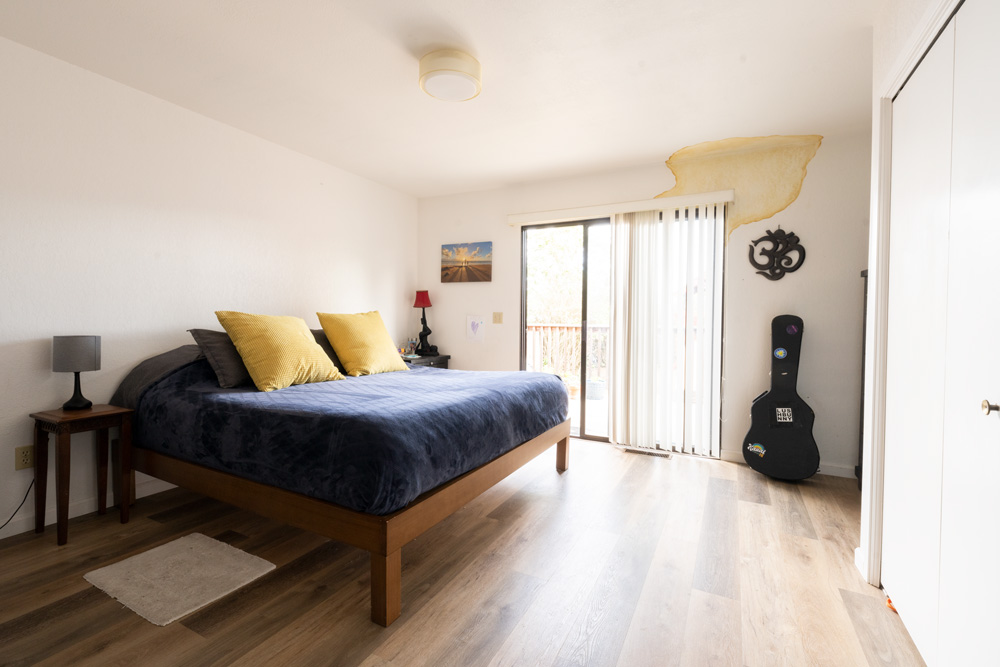
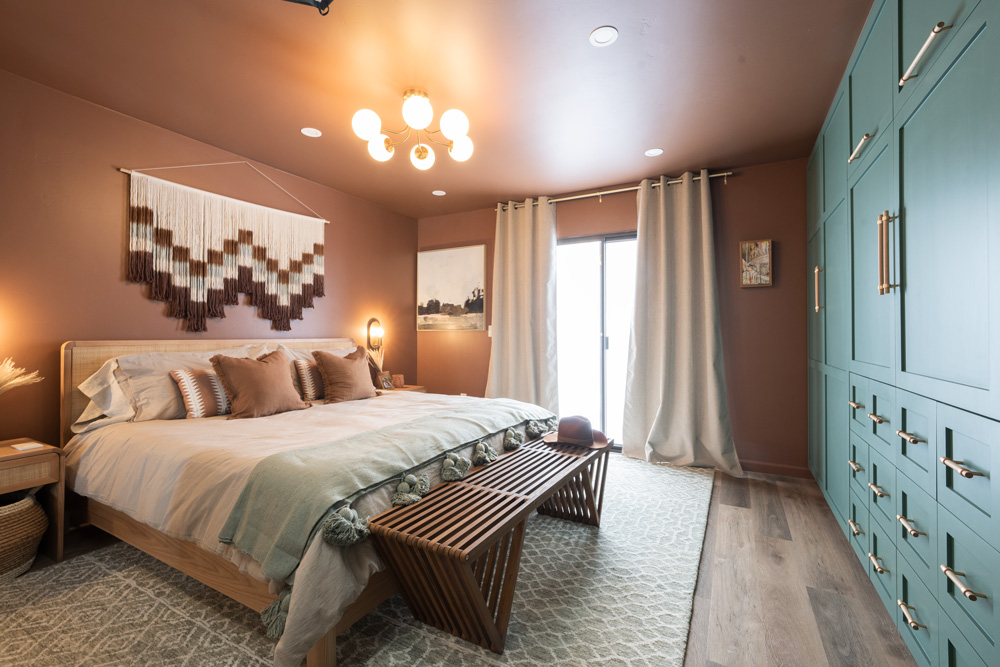
Stain Coverage
The main goal of this room refresh was to remove any trace of the water stain and get rid of its foul odor at the same time. To do this, we primed over the water stain using KILZ RESTORATION® Interior Primer then painted the walls, ceiling, and molding with Rio Rust, a color by Behr Paint.
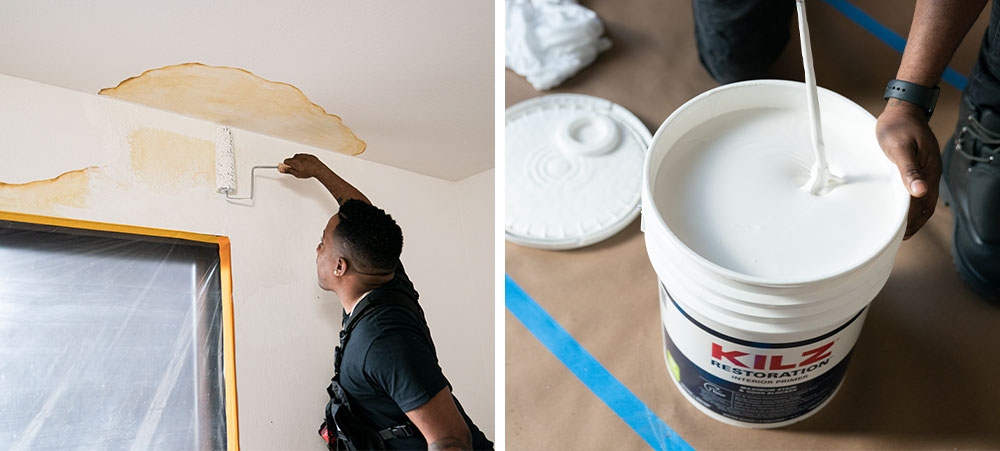
Extra Storage
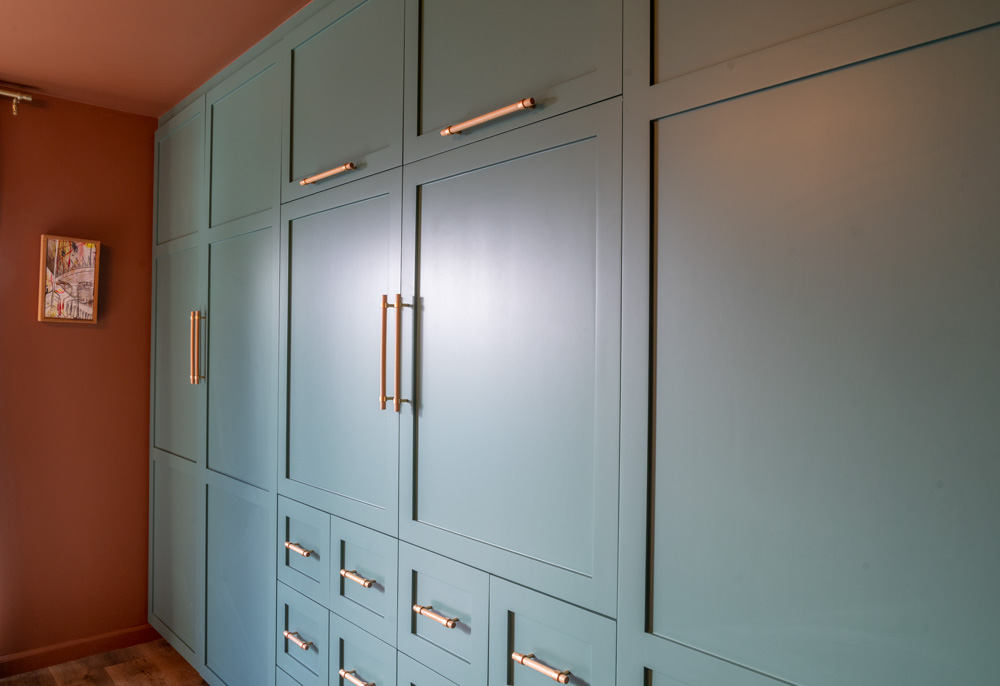
To replace the lackluster closet, we added a custom, built-in closet system with a hidden TV display, perfect for unwinding after a long day. We primed the unit, and then painted it with Forest Edge, a color by Behr Paint, for its ability to stand out and complement the color of the rest of the room. Together, these colors elevated the room and gave it a warm, modern, and cozy feel.
Other Changes
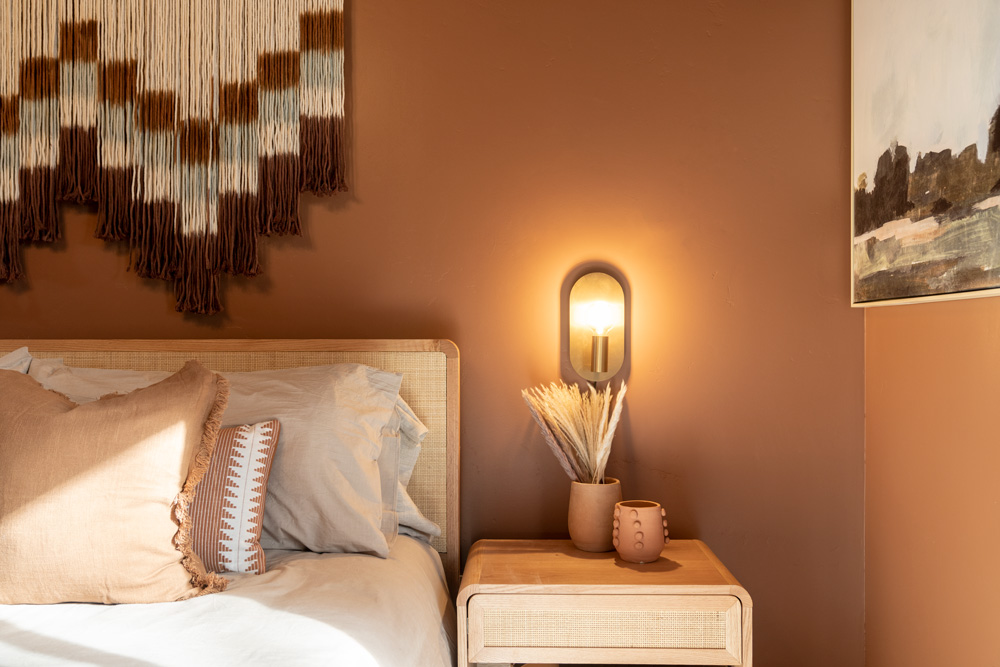
We wanted to update the existing lighting to complement the new design and bring more warmth to the space, so we added a modern chandelier by Kichler Lighting, as well as additional recessed lighting fixtures on the ceiling. We also replaced the door hardware, updated the electrical throughout, and added carefully chosen décor to bring this refined boho-chic look together.
Why Do You Need to Prime?
Priming is essential for proper surface preparation for any paint project. It’s the difference between a job done and a job done right. Priming helps solve a wide range of problems, including highly porous surfaces, stains, odors, uneven surfaces, texture differences, and adhesion problems.
Because this room required stain coverage we used, KILZ RESTORATION® Interior Primer for its superior, water-based sealing and stain blocking formula. It can tackle tough stains from heavy water damage, rust, smoke, nicotine, grease, tannin, ink, pencil, felt marker, pet stains and more. It’s also a champion odor blocker and can be used on many interior surfaces including drywall, woodwork, plaster, masonry, brick, painted metal, ceramic tile, glass, and most other glossy surfaces.
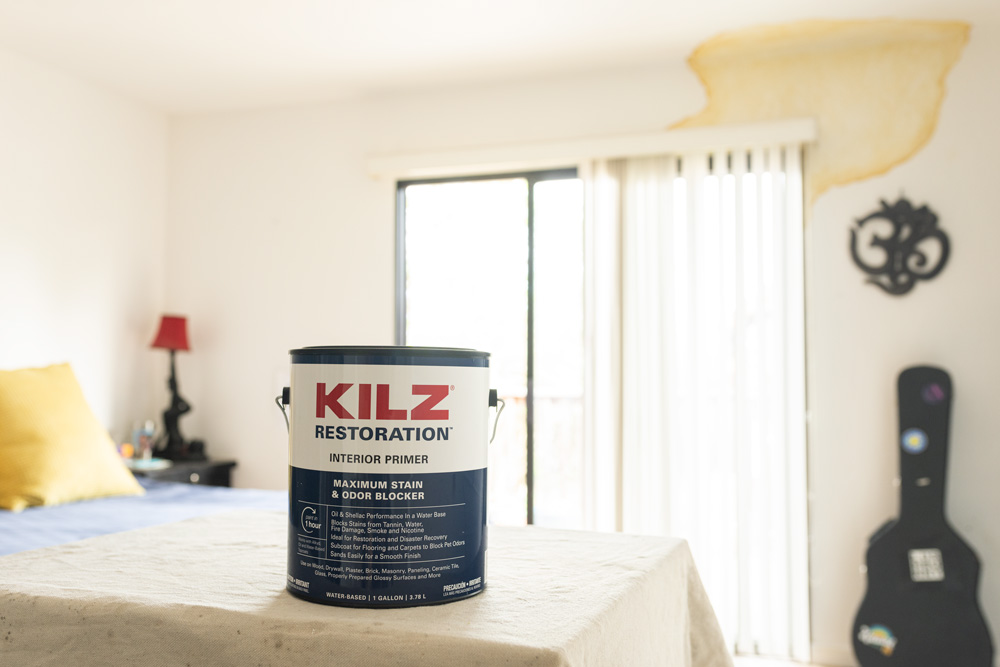
Step-By-Step Guide to Stain Blocking and Priming Walls:
Painting over water stains requires a few basic steps from start to finish. Here’s an easy guide to follow for your next project:
1. Patch any holes from damage and sand smooth to prep the surface (if needed)
2.Thoroughly clean your surfaces with a damp cloth to ensure they are clean and free of dust. Allow to dry.
3. Tape around the baseboards, trim and moldings.
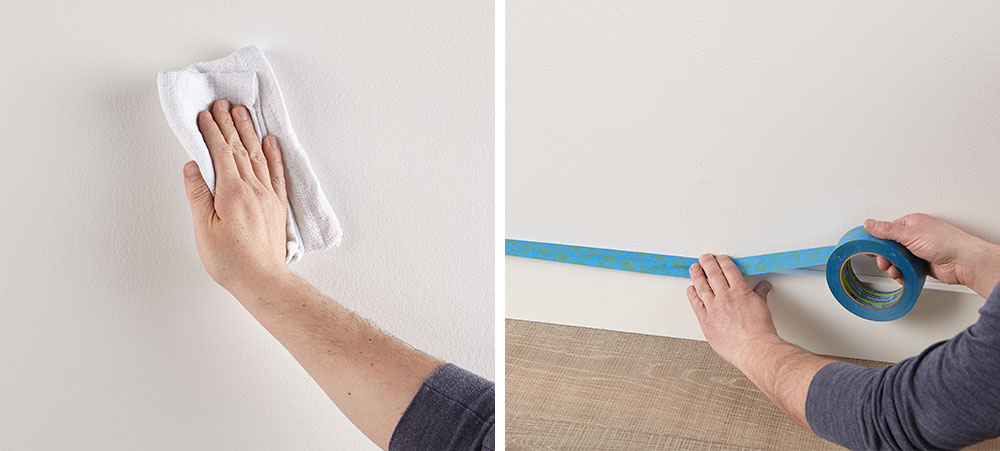
4. Protect your floors and furniture from paint and primer by covering it with a drop cloth or plastic sheets.
5. For major stains like water, grease, or smoke, select a heavy-duty stain blocker like KILZ RESTORATION® Interior Primer.
6. Now it’s time to prime! Using a brush first to “cut in” around the edges and small crevices, then use a roller to fill in the larger areas.
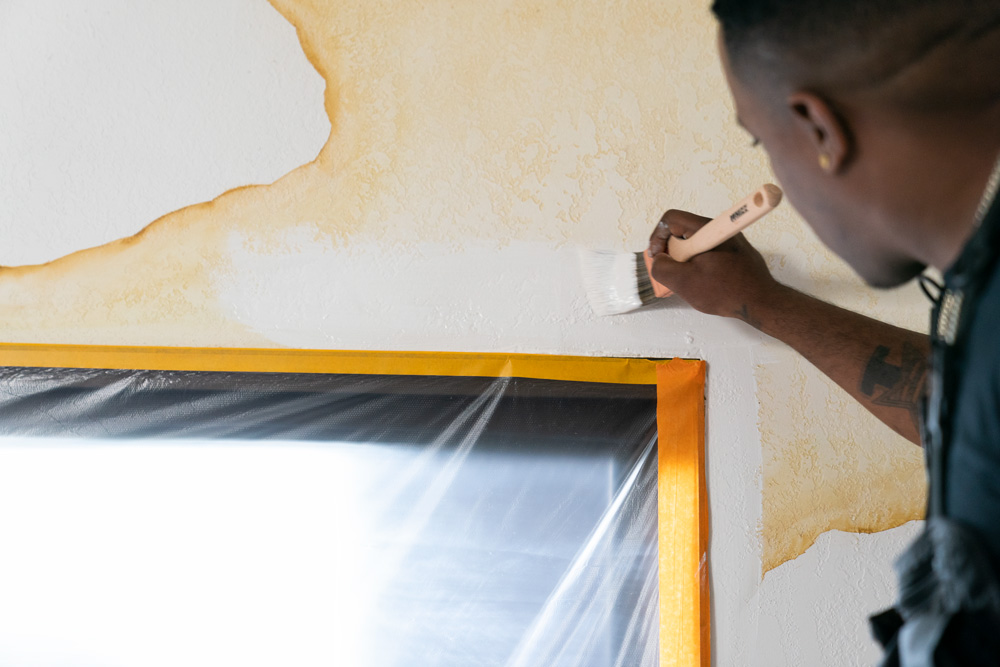
7. Allow to dry for 1 hour.
8. Once the primer is dry, apply paint of your choice using the same application process at the primer.
9. Remove the painter’s tape before your paint is fully dry.
You Will Need:
• Dust mask
• Pole sander with sandpaper, 60-80 grit
• Extension pole for prep and painting, 3’-7′
• Step ladder for hard-to-reach areas
• Rags to wipe dirty and dusty surfaces
• Painter’s tape
• Drop cloths, canvas, or other reusable material
• Plastic sheets, for protecting furniture
• Spackle and applicator
• Paint roller, brush, and paint tray
• Paint of choice
• KILZ RESTORATION® Interior Primer
We hope this episode of Destination Restoration inspires you to tackle your own bedroom remodel this year. Be sure to keep KILZ® products in mind for your next project, and come back for more ideas, tips, and project inspiration.
If you loved this restoration, be sure to check out the other episodes of Destination Restoration. Jason and Jared took on the Kitchen, Living/Dining Room, and Primary Bathroom.
Always remember to refer to our website kilz.com or product back labels for additional information on which primer is right for your project and detailed instructions on how to apply our products. Check out our Coverage Calculator to understand your estimated paint needs for your upcoming project.
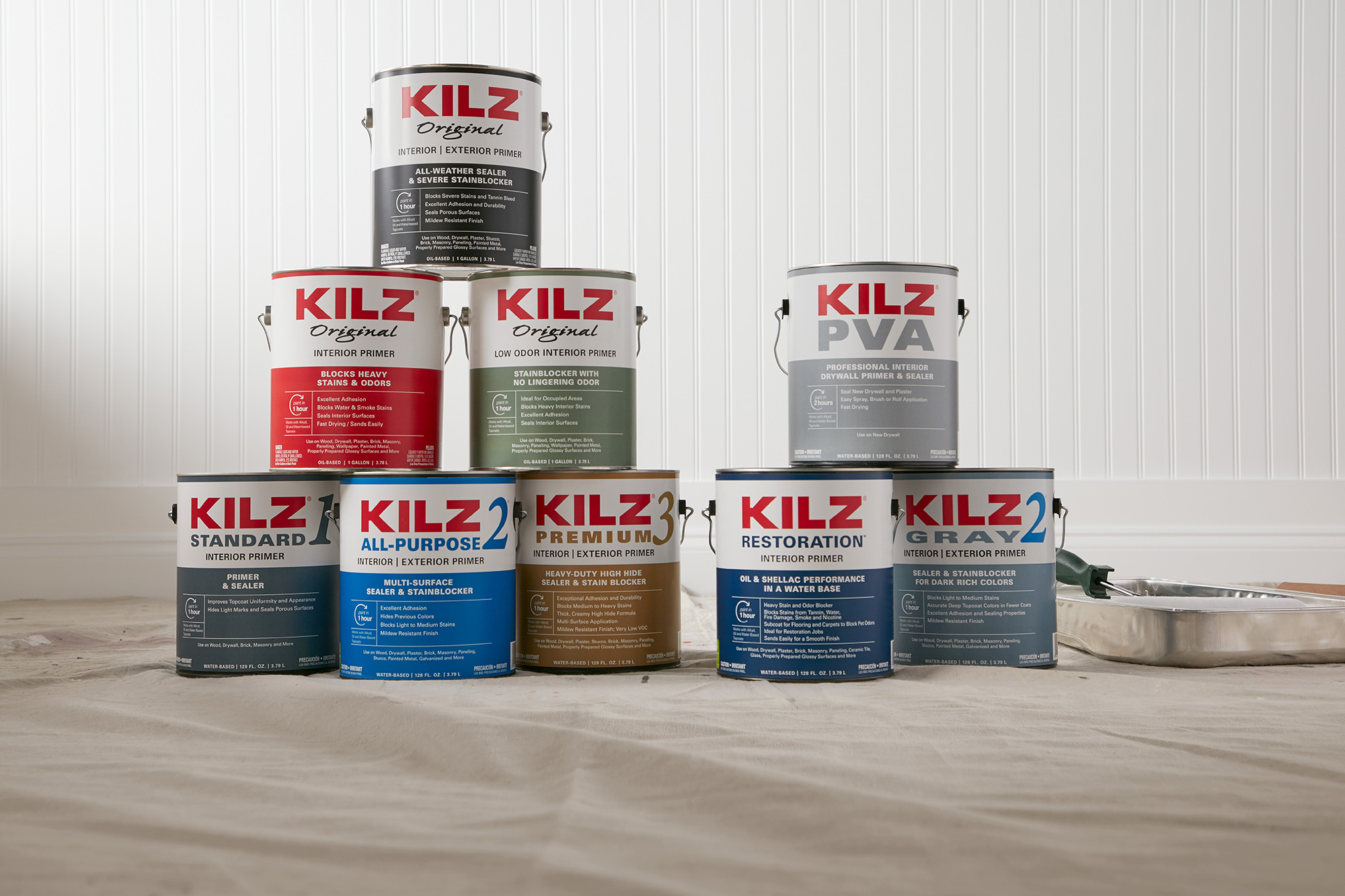
Choose the Right KILZ® Primer for Your Substrate
February 23, 2023Whether you’re painting inside or outside your home, choosing a primer suitable for the surface is the difference between success and, well, a not-so-great job. That’s why there are several different KILZ® Primers to choose from.
Starting with the right primer could prevent your paint from failing. So, we’ve asked our primer expert, Product Manager John Golamco to answer a few questions about primers and surfaces (substrates) for us.
What to know before starting a paint project
Before beginning any painting project, Golamco says it’s crucial to identify the type of surface you want to prime and paint. Because different substrates accept coatings differently, KILZ formulated with each surface type in mind.
Once you’ve identified the surface type, take note of its condition. Are there any particular circumstances that need addressing before applying a coating? Attend to things like peeling paint, mold or excessive dirt first.
Finally, determine the environmental conditions of the location. Is it damp? Are you painting outside where the surface is exposed to the weather? Or will the paint be subjected to extreme temperature fluctuations? Each of these conditions dictates the primer and paint you choose to use.
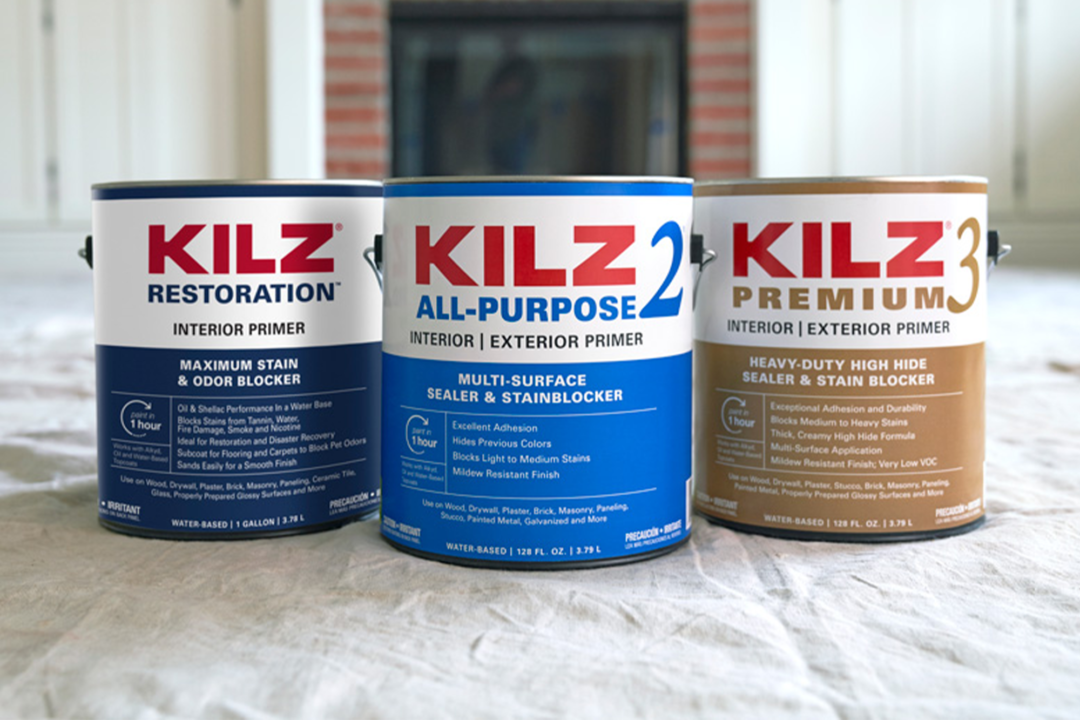
Correctly identifying the substrate
Drywall / Gypsum Board
Most interior walls and ceilings are covered in drywall. According to Golamco, the new drywall is very porous and absorbs much paint. So, to avoid applying excessive coats of paint to get the desired color and finish, he recommends using a drywall primer or PVA. The primer will seal the surface before painting so that less paint is required. Since paint typically costs more than a primer, you get a superior finish with less cost. Priming drywall also smooths out the finish and evens out seams, giving better results with fewer coats of paint.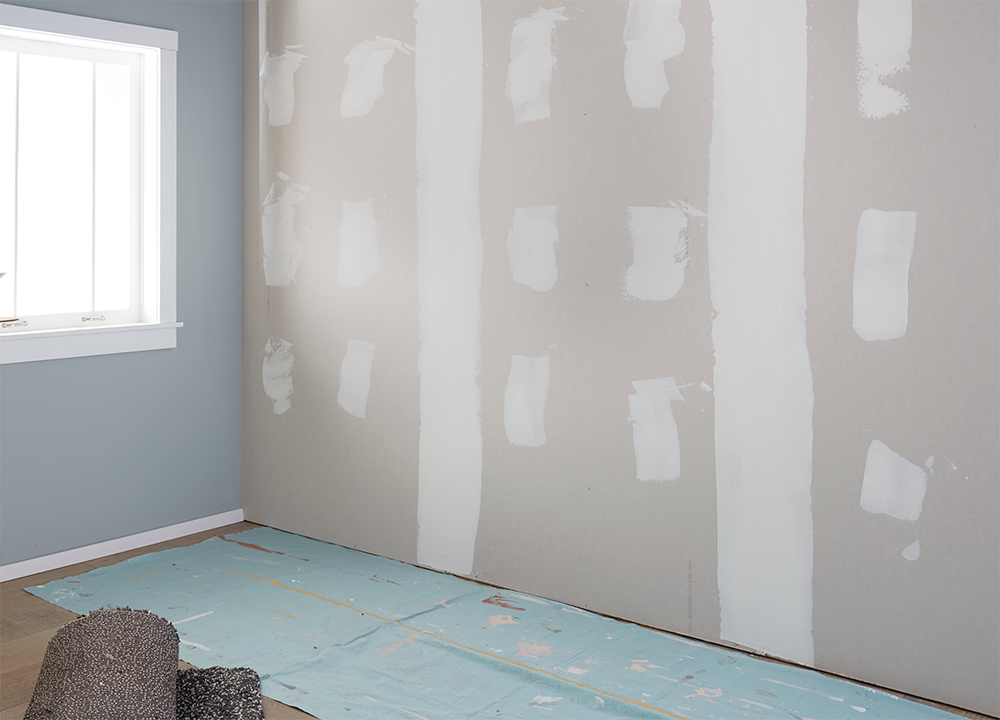
Unfinished wood
Bare wood is porous and grainy. A primer penetrates the wood fibers, seals the porous surface, and creates a smooth, even surface. Golamco says that applying paint to bare wood without a primer coat produces a dull, blotchy finish. Also, some wood species, like red wood , secrete tannins that could leach through the topcoat paint, impacting its appearance. To avoid this, apply a stain-blocking primer to the bare wood before finishing with the topcoat.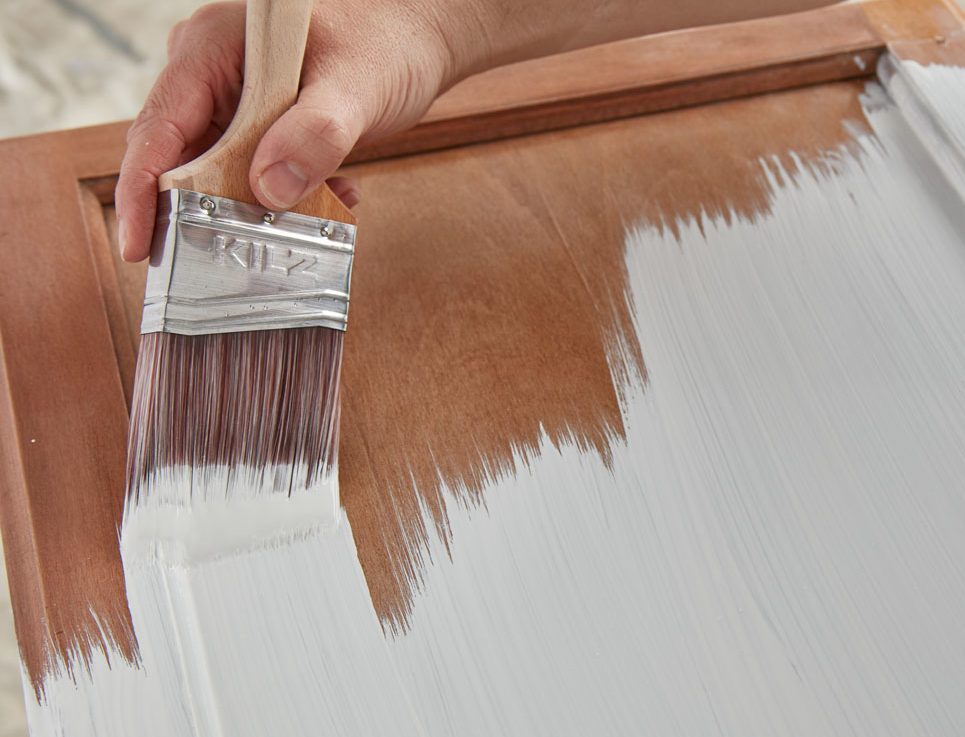
Masonry/ Cement
A coat, or two, of primer seals porous surfaces like masonry and concrete, creating a smooth finish for the paint to go on. Without primer, masonry tends to absorb too much paint. And as with drywall, you’ll need to apply more coats to account for the uneven porosity and color. Also, according to Golamco, fresh concrete has a high pH value because its cement binders contain many alkalis. Their presence causes adhesion problems when applying paint and can cause the topcoat color to fade (alkali burnout). But an alkali-resistant primer will better help the paint bond to the masonry and protect the finish over time.
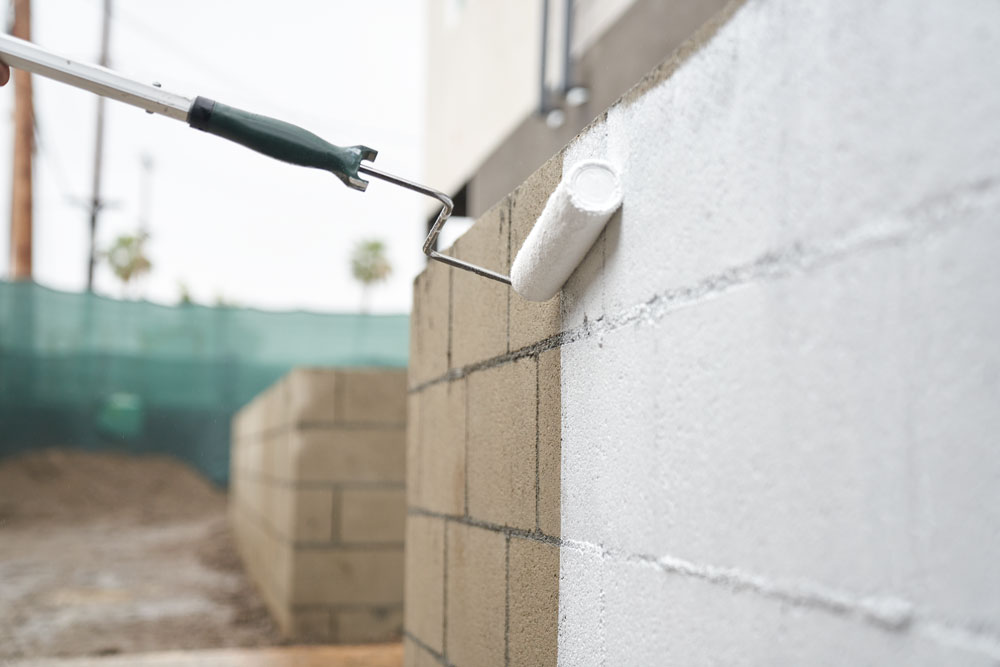 Metal
Metal
Many people don’t realize that some metals can rust under a paint coating, especially if the metal surface is exposed to moisture. For this reason, it’s essential to prime metal surfaces before painting, particularly when it’s uncoated or bare. Golamco says that metal primers have unique ingredients to make the metal more resistant to rain, humidity, and salt, which cause corrosion.
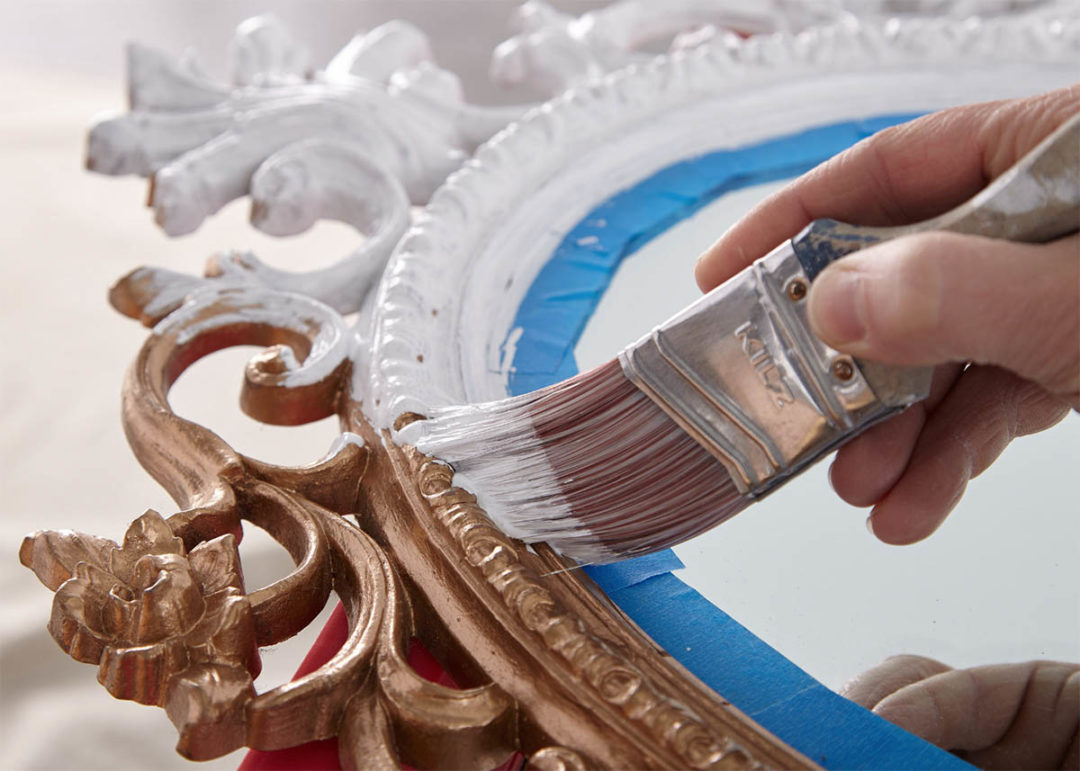
Plastics
Since plastics are non-porous, paint doesn’t like to stick to them. As a result, paint on plastic often cracks, blisters, or peels. Golamco recommends first sanding the plastic surface, especially around any edges, curves, and areas with intricate detail to prevent this. Once sanded and cleaned, he says to prime the plastic with a high-adhesion primer. This process will help the topcoat paint adhere the way it should.
The importance of choosing the right primer
Applying primer before painting ensures a beautiful outcome that lasts, but not all primers are created equal. KILZ Primers are engineered and formulated to solve the unique types of challenges presented by different substrates.
“Some multi-purpose primers solve a combination of issues with one product,” said Golamco. “But they’re not formulated to address more severe or complex issues.” If you know the surface type, its condition, issues to be addressed and the environmental factors, then this can help you to choose the right primer for the job. So, if you want to cover a dark color with a light one, paint metal to prevent corrosion, or any other challenging substrate, use a specialty primer for a successful outcome.
Check out the chart below for the best primer for your project!
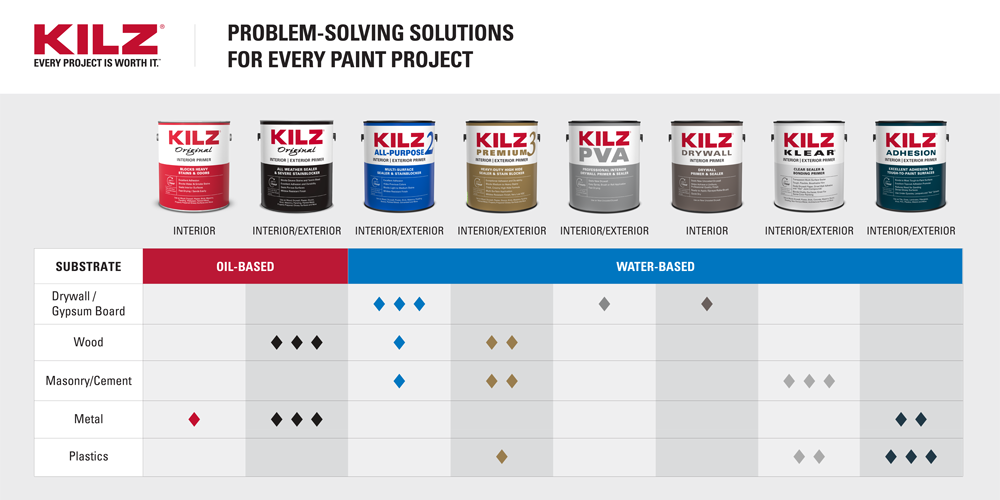
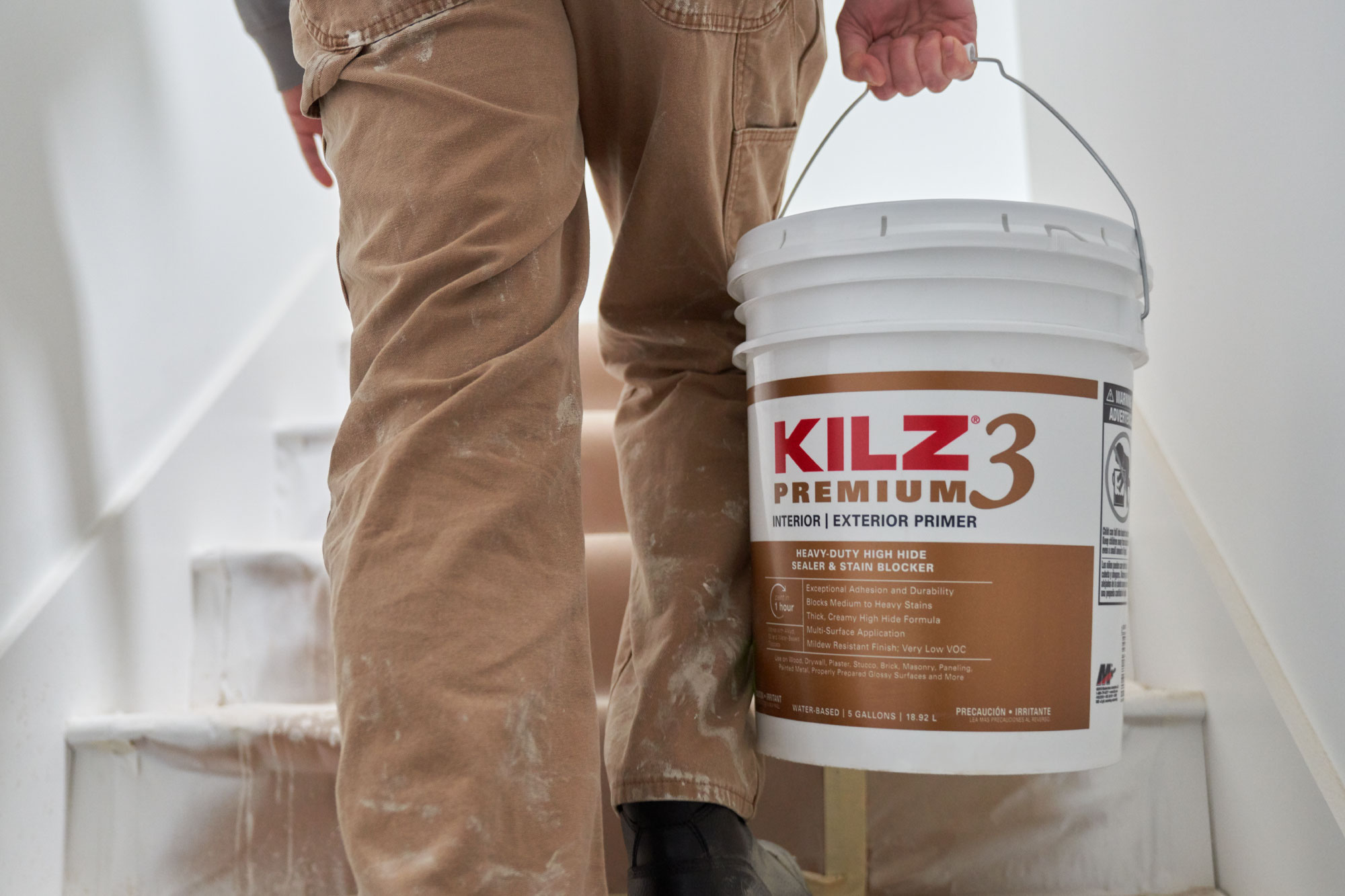
Tips from the Team
January 17, 2023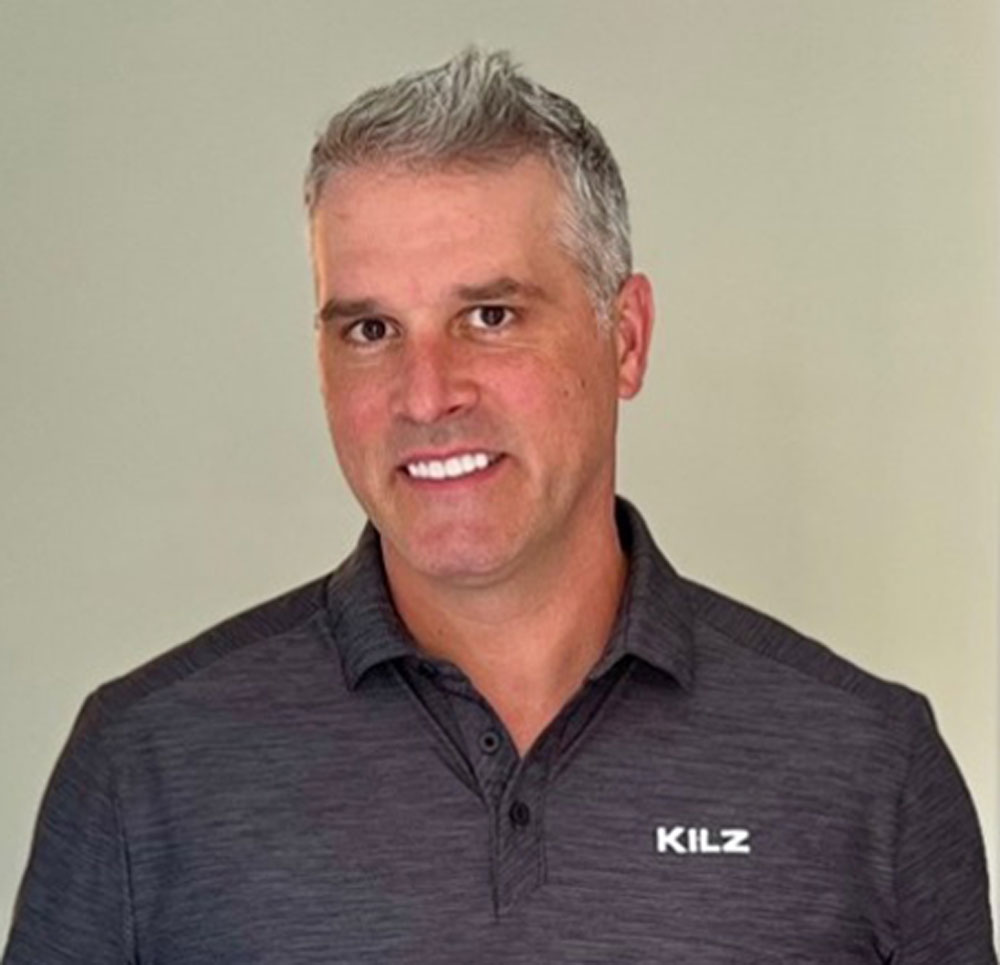
Here on the Perfect Finish, we are starting the year 2023 with our favorite paint category: Primer! Thomas McEvoy, a KILZ product trainer and training content developer, teaches us the importance of preparing the surfaces of your home and using primer during any painting project. Thomas’s favorite part of working for Behr Paint Company and with the KILZ team is the people and their enthusiasm to make the best products and service experience for our customers. Thomas has been with Behr for 20 years and is here to share his experience with you to help get prepared for your painting project.
Why should an individual prep the surfaces of their home?
Preparation is critical because most paint failures, such as paint peeling, old color bleeding through, and wear and tear over time, occur because of skipped prep steps. The best way to prep the surface is to promote adhesion (how the paint sticks to the surface), sealing (adding a protective coat), and stain-blocking if needed. Using a suitable primer promotes adhesion by bonding the surface that adheres to the topcoat. Using the right primer can achieve the aspects of a properly prepared surface.
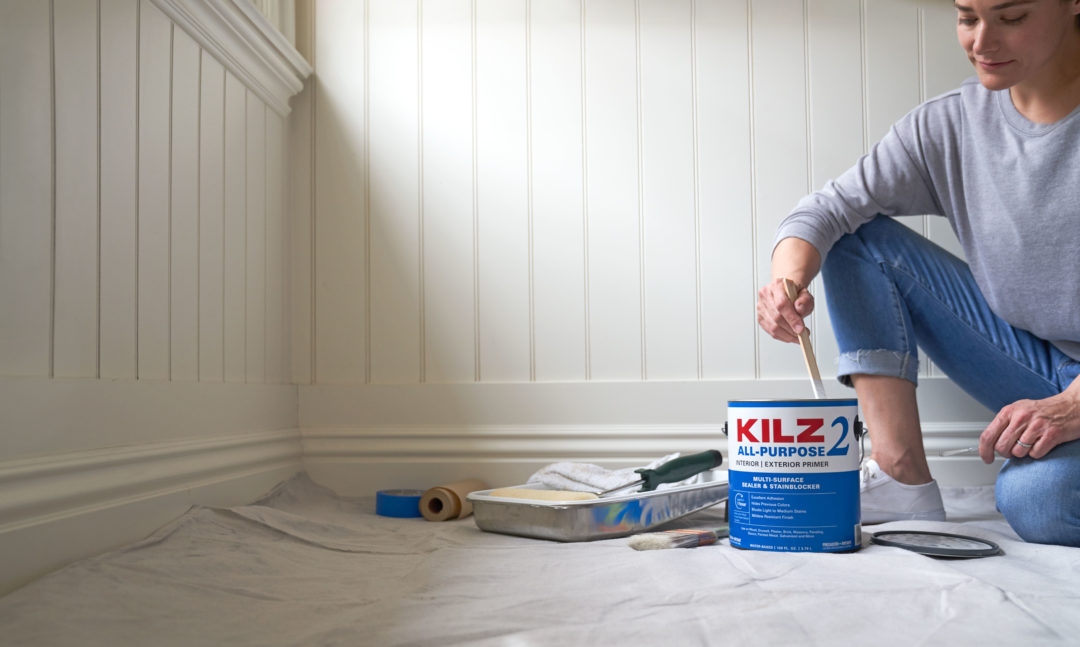
How do I properly prepare a surface before priming and painting?
Here are a few ways to prepare your surface.
1. Lightly sand hard or slick surfaces to promote adhesionSanding can also remove physical imperfections accumulated over time. Any surface that has been lightly sanded during prep will usually lead to a softer texture after painting.
2. Painting over unsealed surfaces can lead to color variation, unevenness in paint sheen, the need to apply more paint, and, eventually, the peeling of the paint. Using a good primer is an important step before painting.
3. When stain-blocking is needed, only the right primer can ensure no bleed through the topcoat. This prep step is critical to ensure we paint over a sound surface.
When is the best time to prepare your surface?
The best time to prep the surface is before you paint and after clearing the space as much as possible and protecting surfaces like carpet and furniture. Time spent on prep will save frustration and added expense later.
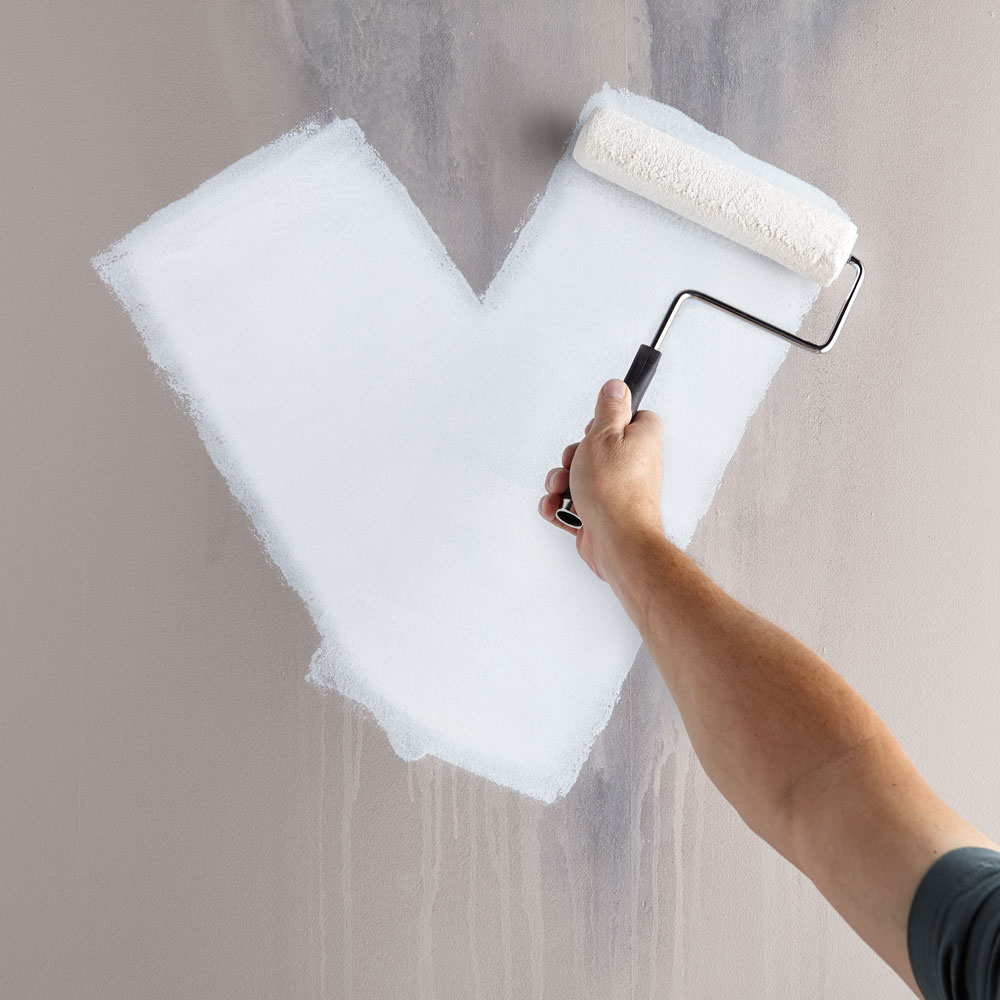
What tools do I need to prepare a surface?
There are many tools to have in a paint kit for current and future projects. A large plastic tote can hold several drop cloths and most smaller tools. I recommend the following tools to get the job done right:
• Dust mask
• Sanding pad, 80-200 grit
• Pole sander with sandpaper, 60-80 grit
• Step ladder
• Painter’s tape for protecting baseboards, doors, and window casing
• Drop cloths, canvas, or other reusable material
• Plastic, for protecting furniture
• Rags to wipe dirty and dusty surfaces
Having the right tools is a critical part of project success. Most of these tools can be used again for many other projects.
Where do I go to find the right primer?
Check out KILZ.com to research the right primer for your project. After, visit your local hardware store or retailer to engage with a thoughtful paint associate that can help with what works for you, and secure the rest of the tools needed for a successful project.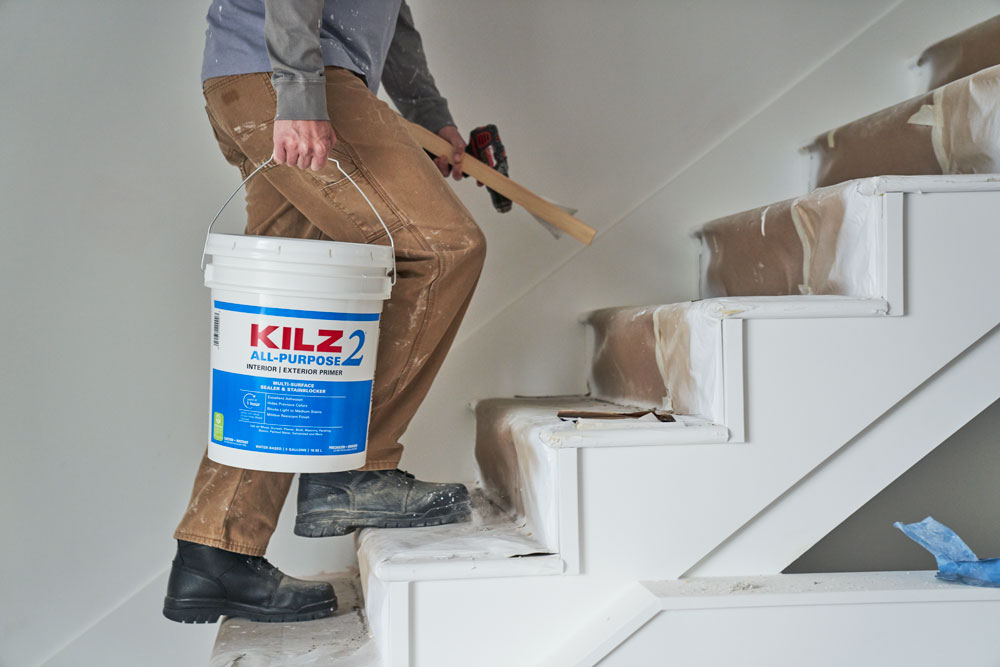
Can I do this myself? Or should I call an expert?
Both are options! You can do this job, or if you prefer, you can call a professional painter to complete your project. Check out your local hardware store and ask a paint associate to help coordinate what is needed for your specific project.
Always remember to refer to our website kilz.com or product back labels for additional information on which primer is right for your project and detailed instructions on how to apply
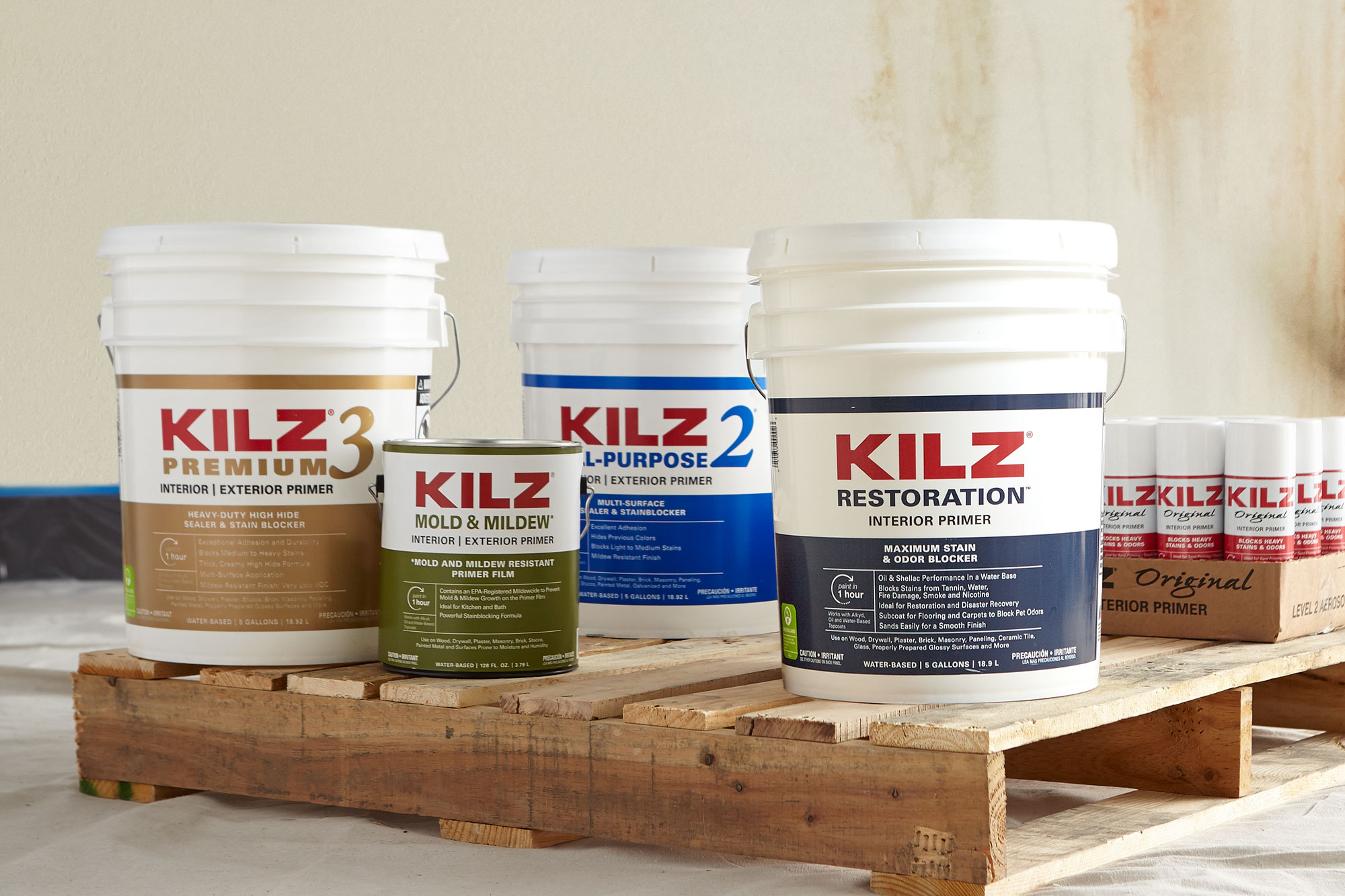
Best KILZ® Primer Products to Use After a Natural Disaster
August 31, 2022When disaster strikes, it’s natural for you to feel defeated. Especially when you finally can assess the damages. Smoke residue from a fire or mold and mildew that creeps in after flood waters recede is a considerable challenge in the renovation process. In many cases, disaster recovery calls for the help of a professional. But if you want to DIY your restoration, KILZ® Primers can help with your painting project. Let’s look at the best KILZ® primers for situations you may encounter in the aftermath of a disaster.
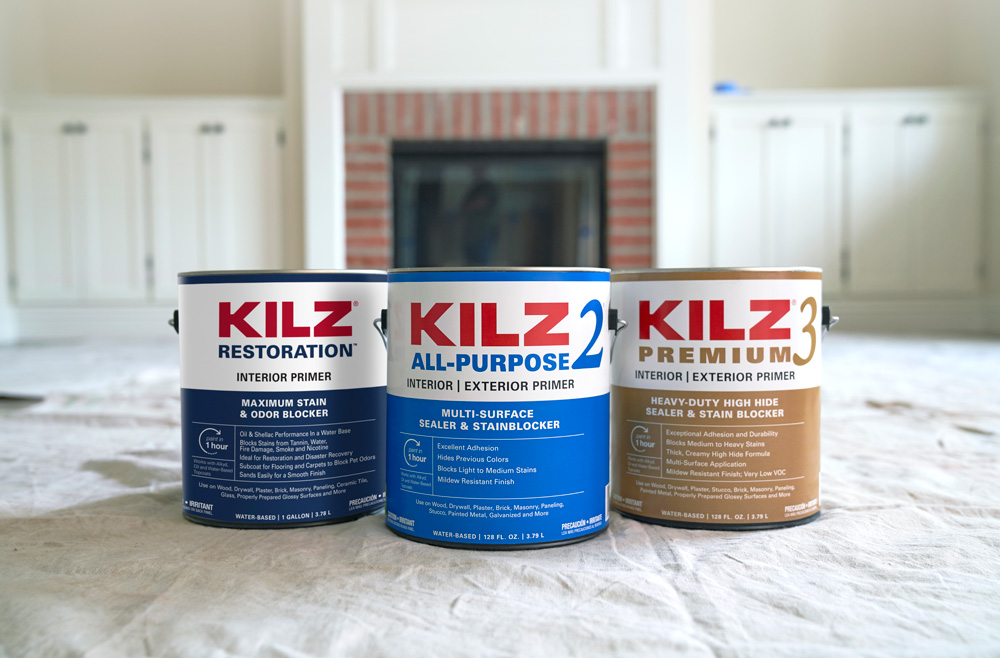
Best KILZ® Primers for Inside the Home
For Smoke Damage
Covering smoke and soot is a tough challenge when painting the interior of your home. Whether the damage came from a wood-burning fireplace or a kitchen fire, you don’t want it to bleed through your fresh paint. That’s why cleaning it properly and using the correct primer before painting is essential. If you have smoke damage in your home, follow these steps to cover it.
1. Clean the surface using a dry cleaning sponge. These natural rubber sponges have tiny, porous cells that work to lift the soot from the surface without smearing or streaking.
2. Wash the surface with a grease-cutting dish detergent and water.
3. Rinse with a solution of one part water and three parts vinegar.
Once the walls and ceiling are squeaky clean, it’s time to prime. Properly applied, primers provide a foundation coat that ensures the topcoat looks its best and lasts longer. The following KILZ® Primer products work tirelessly at blocking smoke stains and odors.
• KILZ® ORIGINAL Oil-Based Primer blocks most heavy interior stains, including smoke, and is suitable for wood, drywall, plaster, paneling, wallpaper, masonry, and brick.
• KILZ® ORIGINAL Interior/Exterior Primer is a fast-drying oil-based sealer that blocks the most severe stains, including those from smoke and fire. And it seals against any lingering smoke odors. Use it on interior and exterior surfaces, including wood, drywall, plaster, brick, stucco and masonry.
• KILZ RESTORATION® Primer (Formerly KILZ MAX) is a water-based primer, sealer, and stain blocker you can cover with either a water-based or oil-based topcoat. Performing like traditional oil and shellac-based primers, it blocks tough stains like smoke and seals against its odor. Use it on drywall, wood, plaster, masonry, and brick.
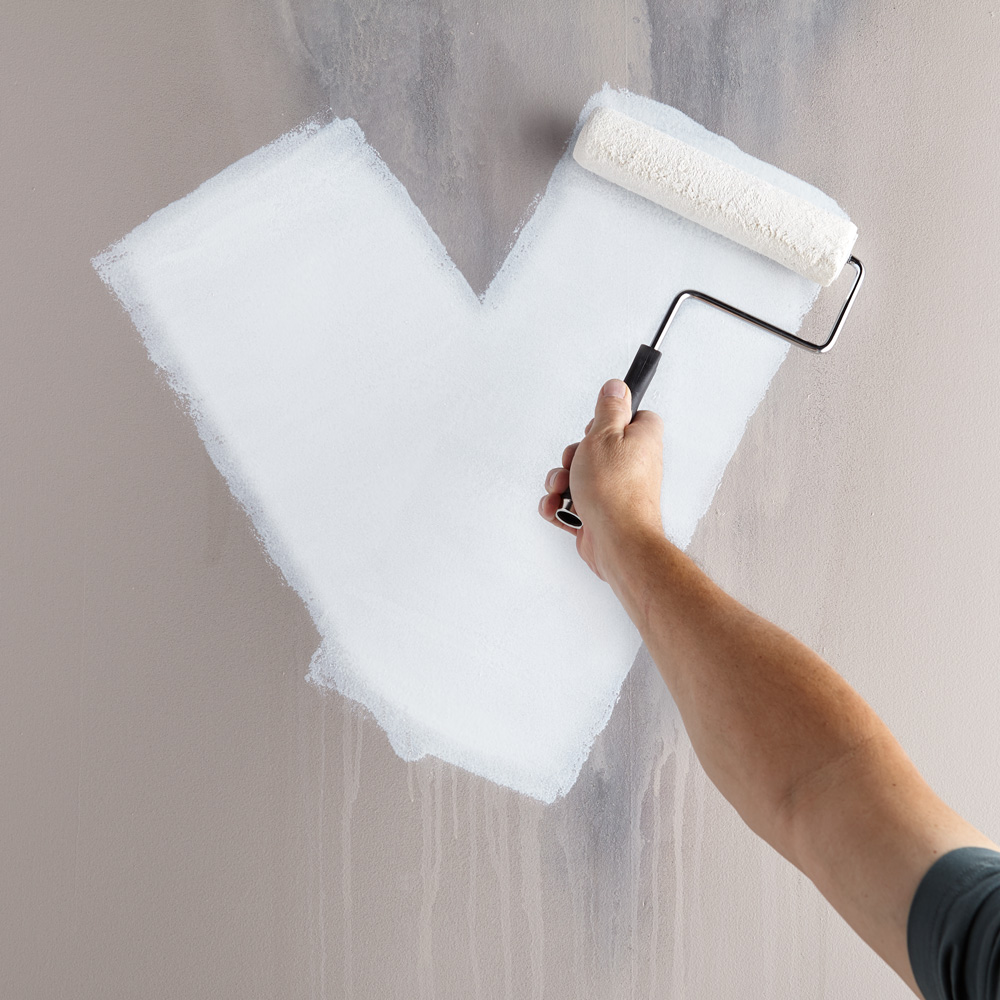
For Water Damage
Anyone who’s lived through a flood understands the shock after the water recedes. There’s a definitive line marking the water level. The drywall is ruined, ugly stains are everywhere, and the smell is nauseating. Unfortunately, the odor comes from another set of problems for homeowners who want to repair the damage left behind–bacteria, mold, and mildew. And all are challenging to cover with paint. If this sounds like what you’re facing after a hurricane, tornado, or flood, KILZ® Primers can help.
Once clean-up is complete and all soil, mold, and mildew removed, you’re ready to prime the surfaces for painting. The following KILZ® Primer products are the best choice for blocking water stains, sealing against odors, or preventing mold and mildew from recurring.
• KILZ® ORIGINAL Oil-Based Primer blocks most heavy interior stains, including water, and is suitable for wood, drywall, plaster, paneling, wallpaper, masonry, and brick.
• KILZ® ORIGINAL Interior/Exterior Primer blocks the most severe water stains and seals against any persistent odors. Use it on interior and exterior surfaces, including wood, drywall, plaster, brick, stucco and masonry.
• KILZ RESTORATION® Primer is a water-based primer, sealer, and stain blocker that blocks tough stains from heavy water stain damage and seals against unwanted odor. Use it on drywall, wood, plaster, masonry, and brick. And topcoat with either water-based or oil-based paint.
• KILZ 2® ALL-PURPOSE Primer (Previously KILZ 2 Latex) is a water-based primer with a mild odor. It’s suitable for multiple surfaces with excellent adhesion and primes, seals, and blocks medium stains from mild water damage. It also has a mildew resistant finish.
• KILZ 3® PREMIUM Primer dries fast, has low odor, and is very low in VOCs. In addition, this water-based primer has excellent adhesion, provides a mildew-resistant coating, and blocks most medium to heavy stains caused by water. Use it on interior and exterior woodwork, drywall, plaster, paneling, masonry, and brick.
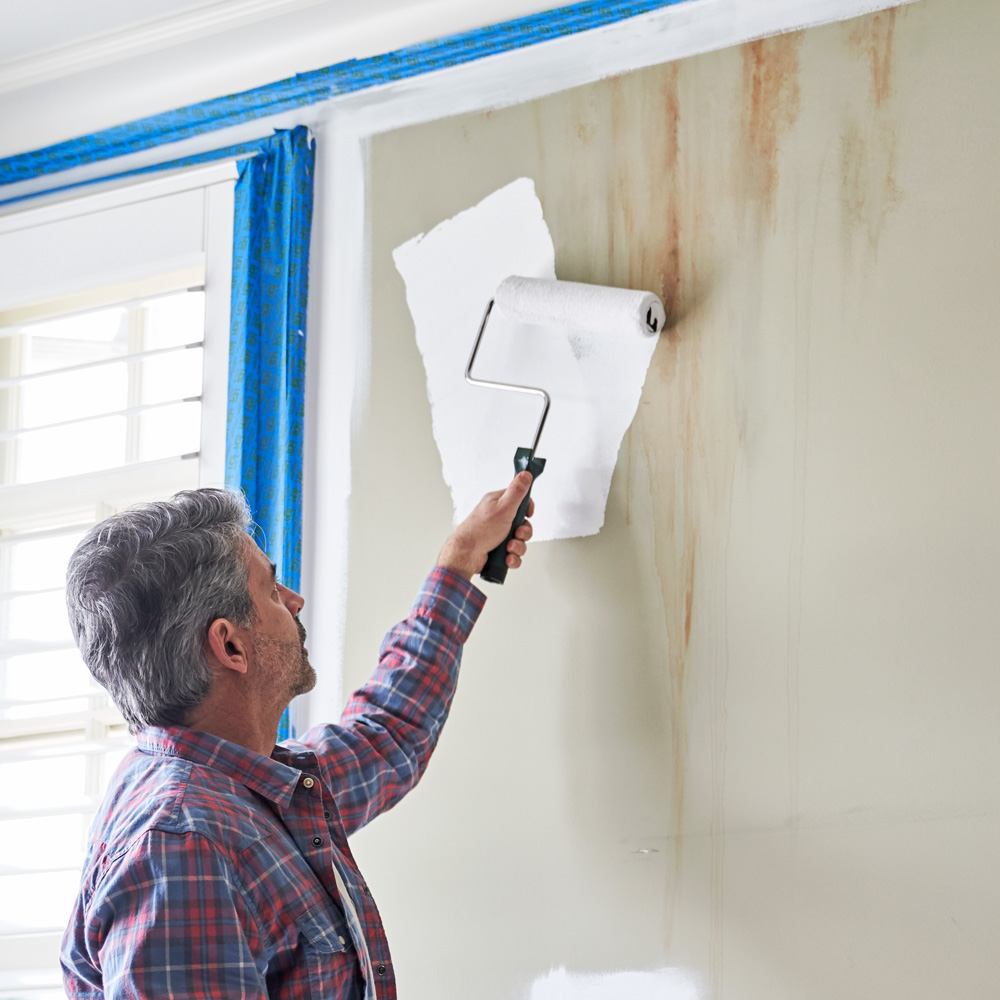
Best Primer for Damage Outside Your Home
Fire, hurricanes, and other storm damage happen outside your home just as readily as inside. For restoration jobs on exterior surfaces, the following KILZ® primers provide excellent adhesion and durability on most surfaces.
• KILZ® ORIGINAL Interior/Exterior Primer
• KILZ® MOLD and MILDEW Primer
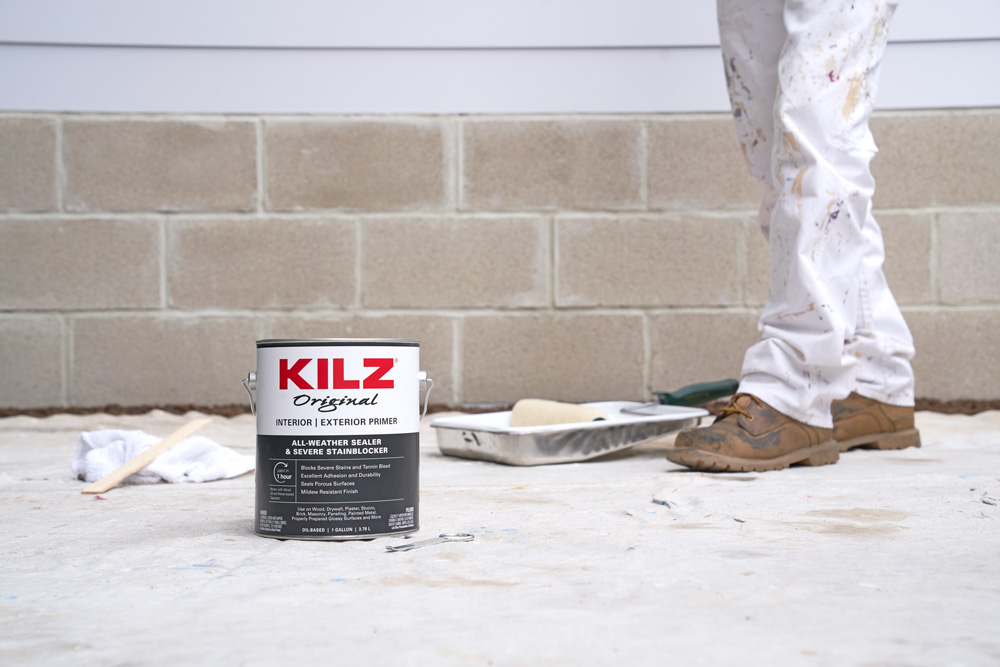
Before Disaster Happens
Primers provide a foundation coat that solves various surface problems, ensuring the topcoat looks best and lasts longer. While it cannot prevent any physical damage from natural disasters, a primer does help the paint stick to the wall better and more evenly, thereby helping to avoid damage to some degree. So, before a tragedy, remember to prime your surfaces with KILZ® primers correctly.
Trusted by pros for over 40 years, most homeowners choose KILZ® products for tackling stains and odors caused by fires, floods, and smoke. They’re available where most paints are sold.
Always remember to refer to our website kilz.com or product back labels for additional information on which primer is right for your project and detailed instructions on how to apply our products. Check out our Coverage Calculator to understand your estimated paint needs for your upcoming project.
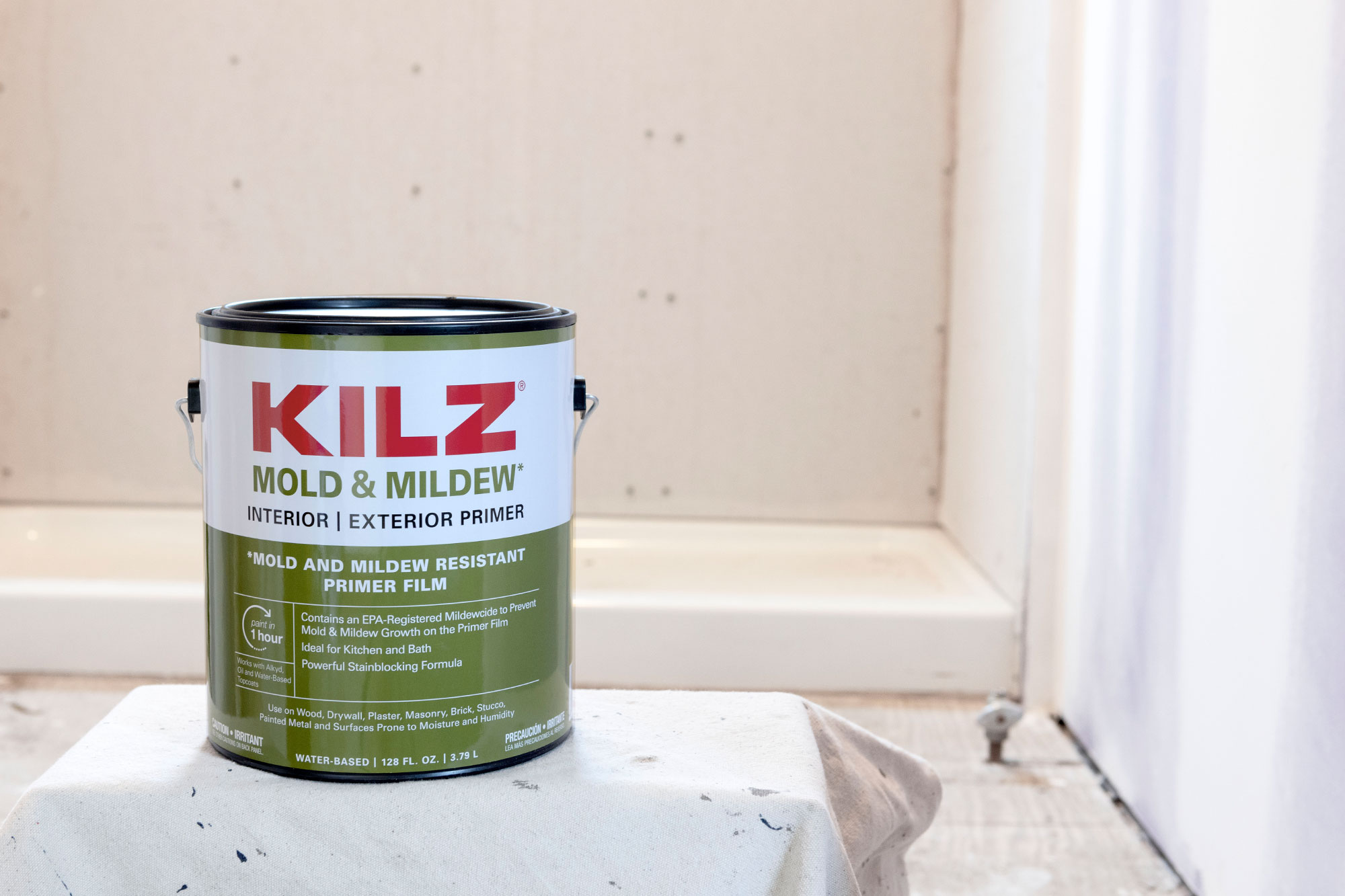
A DIY Bathroom You Can’t Wait to Show Off
August 31, 2022While your bathroom isn’t exactly a gathering place like most of the other rooms in your house, it’s one of the most visited. If that’s not reason enough to make it as comfortable and pleasant as possible, our bathroom inspiration makeover will give you just the push you need to elevate yours with style and functionality in mind.
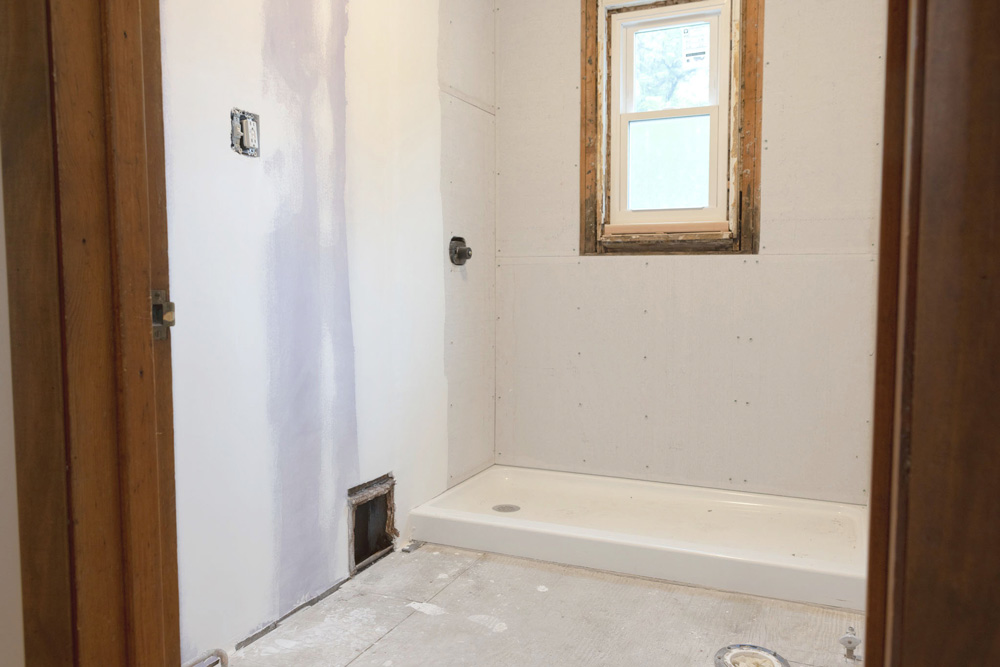
If you’ve ever visited a bathroom outside your home and been impressed by its aesthetic, you know this is a room with great potential to shine. And while our bathroom renovation is modest and family friendly, it has its own unique flair as well. Our simple, yet chic, farmhouse-inspired look is basic enough to work inside any home, but with a few thoughtful details, it’s also distinguished and refined.
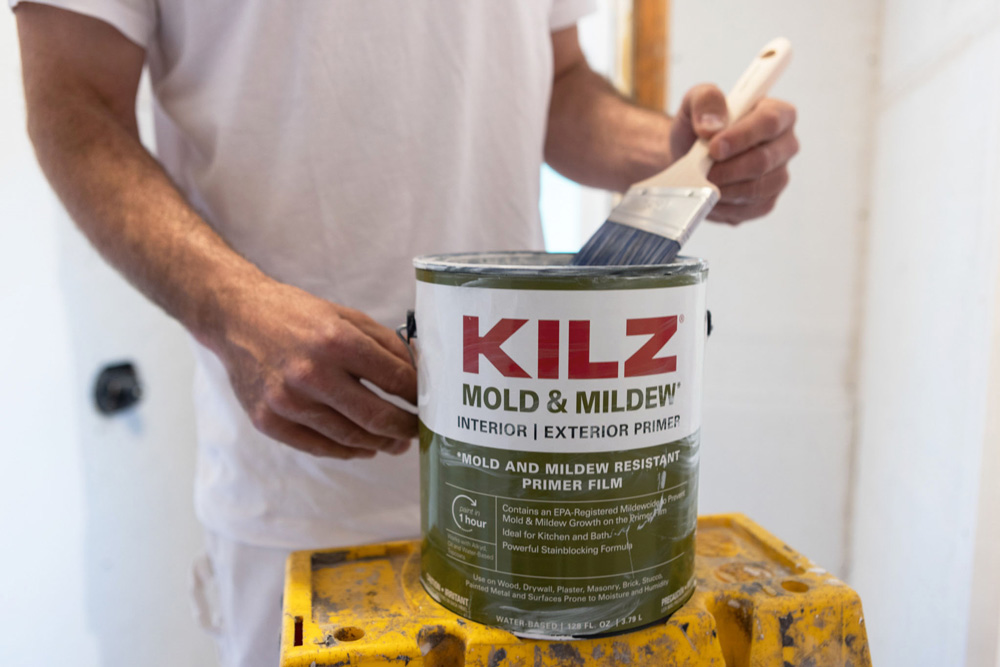
After the initial labor—removing the drywall, fixtures, bathtub, etc.—we were able to prime the old, brown walls before applying a fresh coat of paint. Because of the moisture-prone nature of a bathroom, the ideal choice for this job was KILZ® Mold and Mildew Primer. This water-based primer-sealer-stain blocker is specially designed for residential surfaces in high humidity, moisture, and temperature environments.
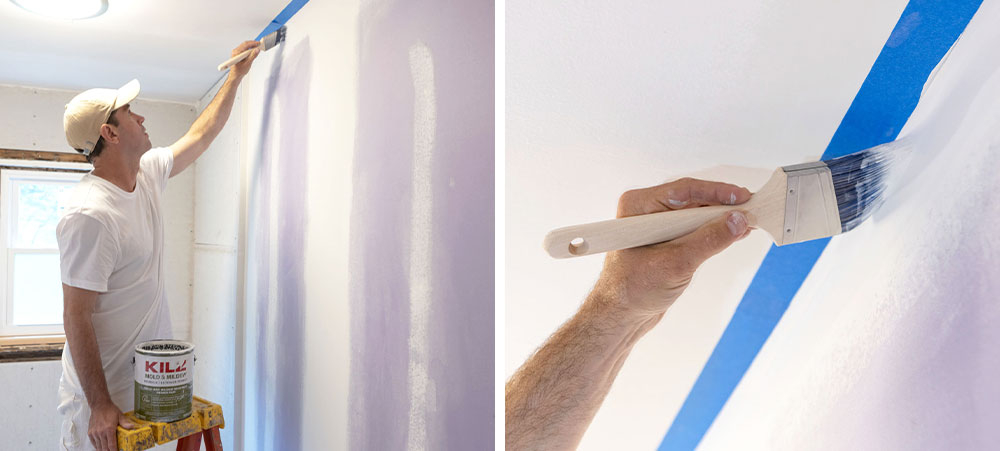
Taking our bathroom walls from dark to light, was a breeze thanks to our primer’s ability to hide the previous color. It offers excellent adhesion and provides a solid anchor for paints. The EPA-registered active ingredient in this primer creates a mold and mildew-resistant film, specially formulated to protect the primed surfaces from these issues so you can paint with confidence.
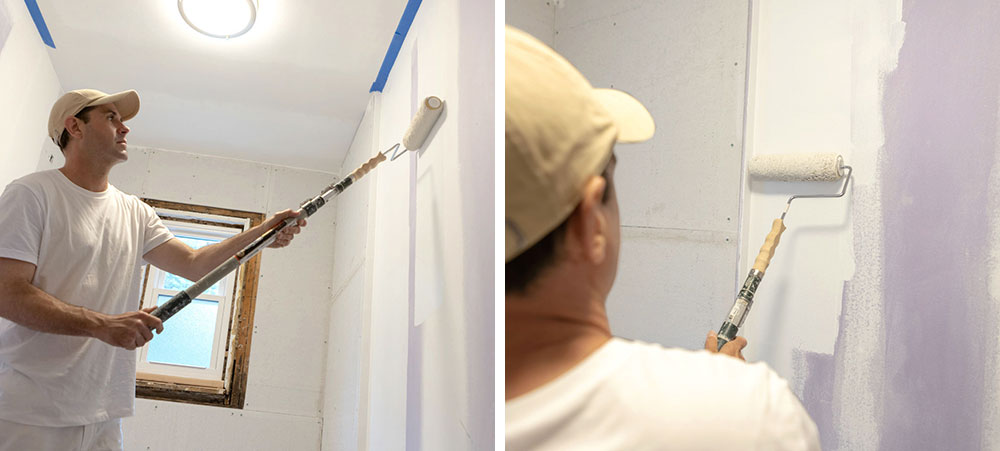
Once dry, painting the walls with a bright, yet neutral white, could not have been simpler. The paint went on smooth and blemish-free, and thanks to our primer, no traces of the previous, dull, brown paint could poke through. Natural light from the window made it easy to build upon the brightness in this space with finishing touches from the fixtures, tile, lighting, and décor. Lastly, the sliding glass shower door creates clean lines, beautiful transparency, and an overall modern feel.
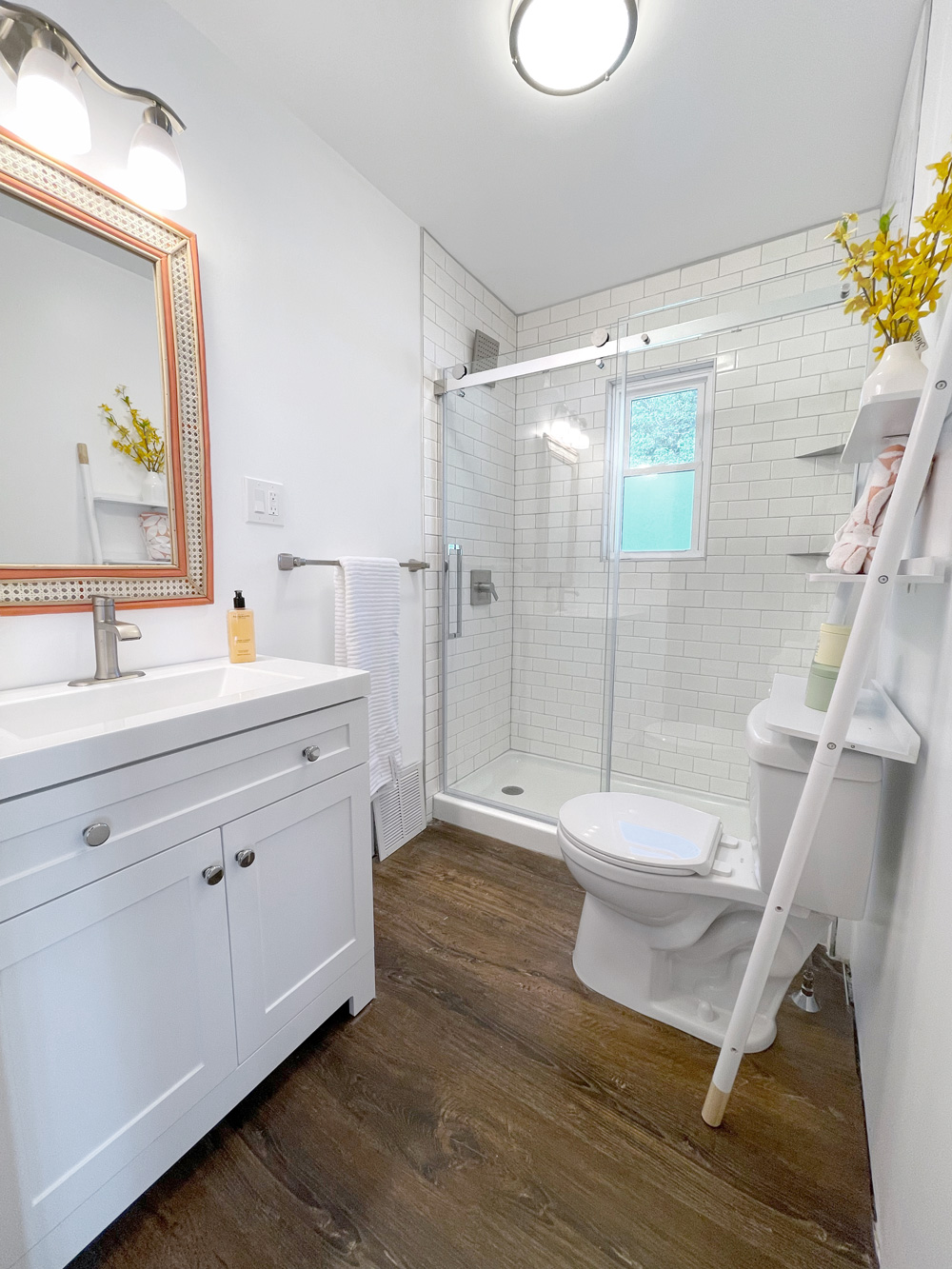
To update an older bathroom, you’ll want to first consider the scope of the project. For example, our renovation included a newly-tiled shower, brand new flooring, updated lighting and fixtures, and a modern vanity. We chose to accentuate brightness by adding decorative accents to complement the color palette, however, you may choose a look that’s vibrant and colorful or something more bold and dramatic. Working out the details is where you get to put on your designer hat and let your creativity shine.
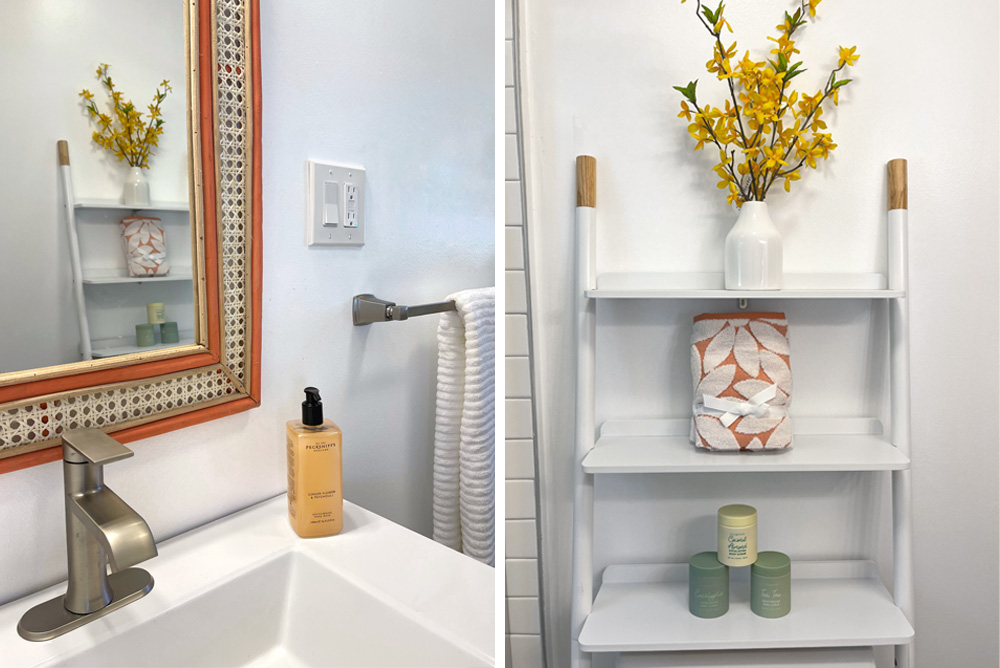
At the end of the day, the perfect primer is essential to achieving a beautiful result, which is why we can’t recommend KILZ products enough for jobs like these. We hope this bathroom makeover inspires you to assemble your group, or embark solo, and create something special in one the most-visited areas of your home.
Always remember to refer to our website kilz.com or product back labels for additional information on which primer is right for your project and detailed instructions on how to apply our products. Check out our Coverage Calculator to understand your estimated paint needs for your upcoming project.
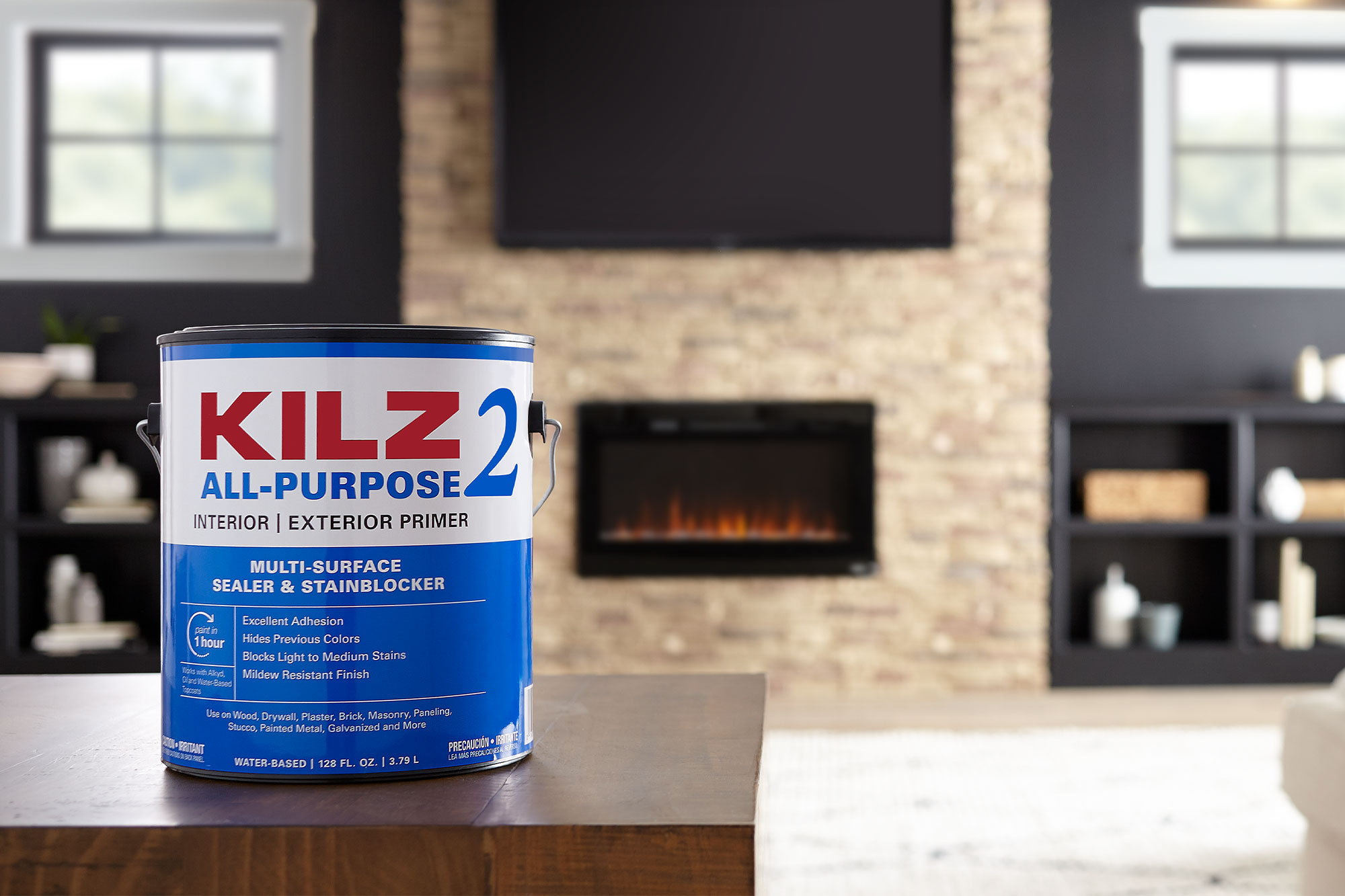
Creating a Family Room that Brings People Together
August 1, 2022Ready to breathe new life into the heart of your home this year? Start your family room renovation before the holiday chaos, and enjoy a space that feels cozy and bright all year long. Your family room should invite people in, feel comfortable, and encourage togetherness, and with the right template, you can create a room that’s not only gorgeous, but also practical, warm, and perfect for gathering with loved ones.
With so many family room designs to choose from, it’s up to you to find the perfect one. We were inspired by a modern farmhouse look, which we achieved with soft white paint, dark accents, and carefully styled décor. Taking our room from light to dark required that we first primed the walls for a better paint application, so we chose KILZ 2® All-Purpose Primer, which simplified the job thanks to its multipurpose formula.
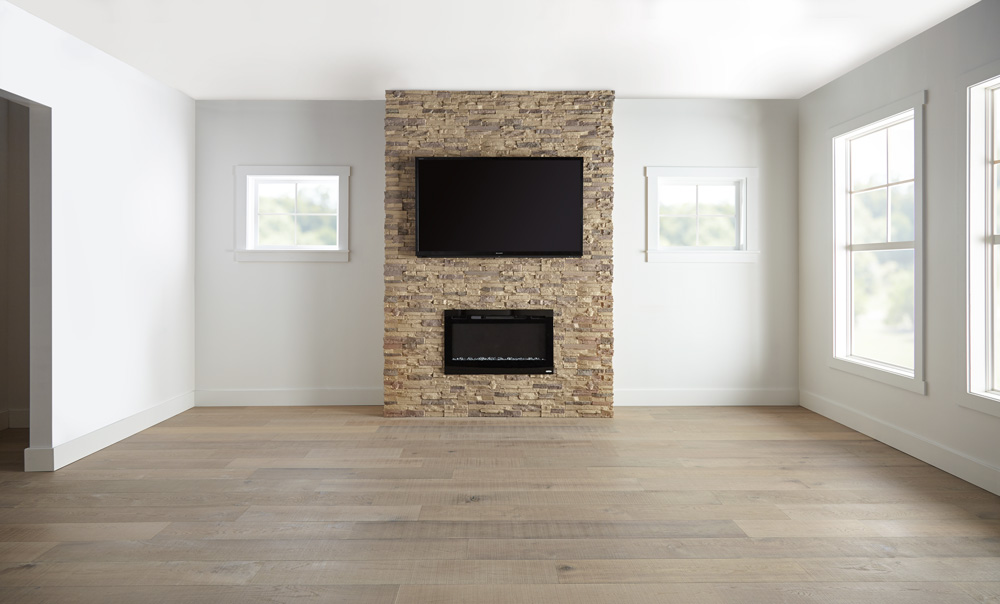
It’s fast drying, water-based, and able to be used on multiple surfaces—such as plaster, drywall, wood, and brick. Great at blocking stains, it also has excellent adhesion, and is mildew resistant with a very mild odor. KILZ 2® All-Purpose Primer helps lessen the number of coats of paint required—a perfect solution for making over your family room quickly and professionally with minimal disruption to your life.
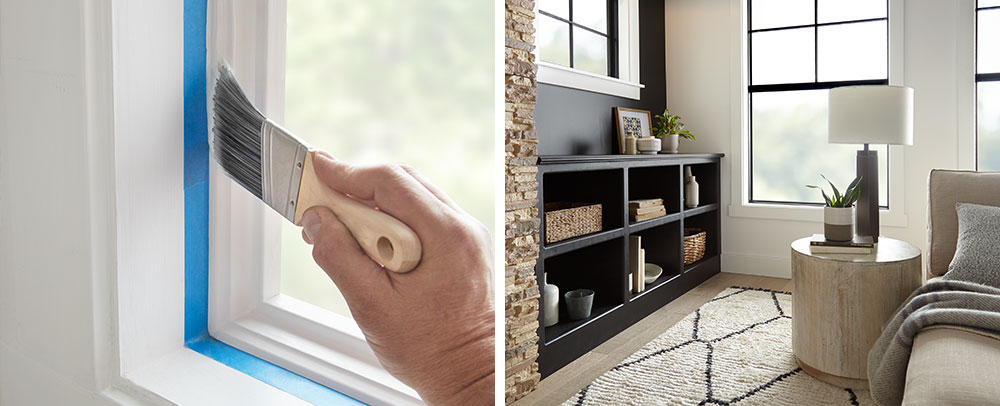
Once primed and dried, we got to work painting our accent walls and cubbies with BEHR® Interior Paint in Carbon N520-7. We also added this color to the inner window framing, to add a bit of depth, and to the beams across the ceiling to further complete the farmhouse look.
For contrast, we used BEHR® Interior Paint in two shades of white to brighten up the rest of the space. For the walls, we chose Shoelace OR-W13, and Ultra Pure White® for the trim and ceiling. The dark accents work to draw focus to the back wall—housing the fireplace and TV—and allowed us to situate the furniture in a way that creates a natural gathering space inside the room. From here, it was time to get creative and have fun with the décor.
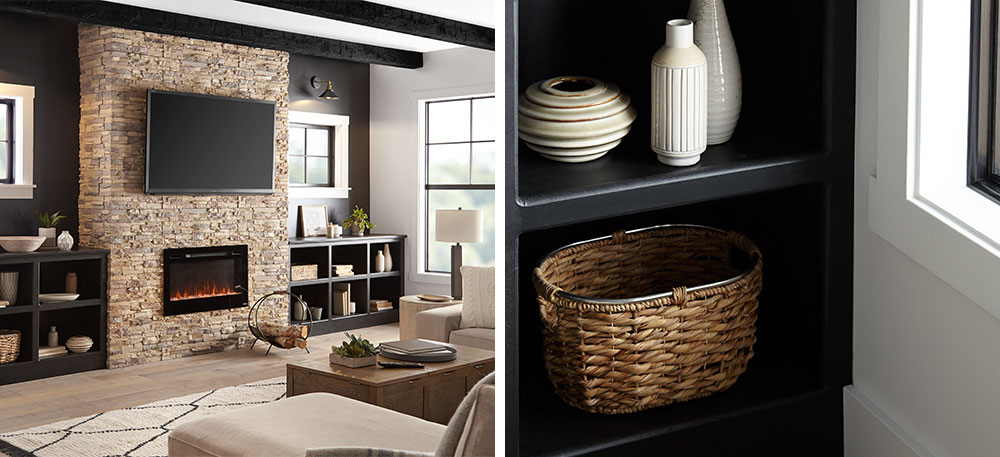
Choosing a neutral color palette was an easy decision because it worked well with the existing brick detail and created an added layer of warmth. We wanted the room to feel relaxed and cozy, yet modern and sophisticated, which our beige couch and area rug help achieve. We brightened up the cubbies with a few wicker baskets, ceramic bowls, and vases, and sprinkled in a bit of greenery around the room. Our wooden coffee table pulls focus to the room’s center, while hints of blue and gray in the pillows and throw help to create a finished farmhouse look.
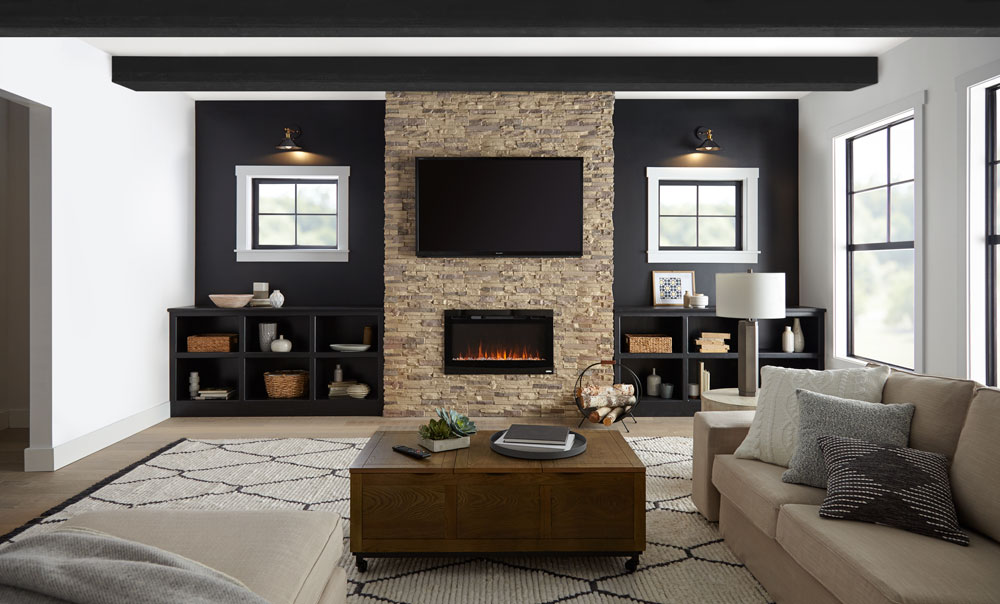
As always, we hope you find this room transformation inspiring. It’s easy to start any project—big or small— with the help of any KILZ® Primer. Whether you choose to embark on this project with friends or family, or go at it alone, once completed, your beautiful, new family room will reward you with memories for years to come. With a bit of time and effort, it’s easy to give your loved ones the gift of togetherness this year.
Always remember to refer to our website kilz.com or product back labels for additional information on which primer is right for your project and detailed instructions on how to apply our products. Check out our Coverage Calculator to understand your estimated paint needs for your upcoming project.
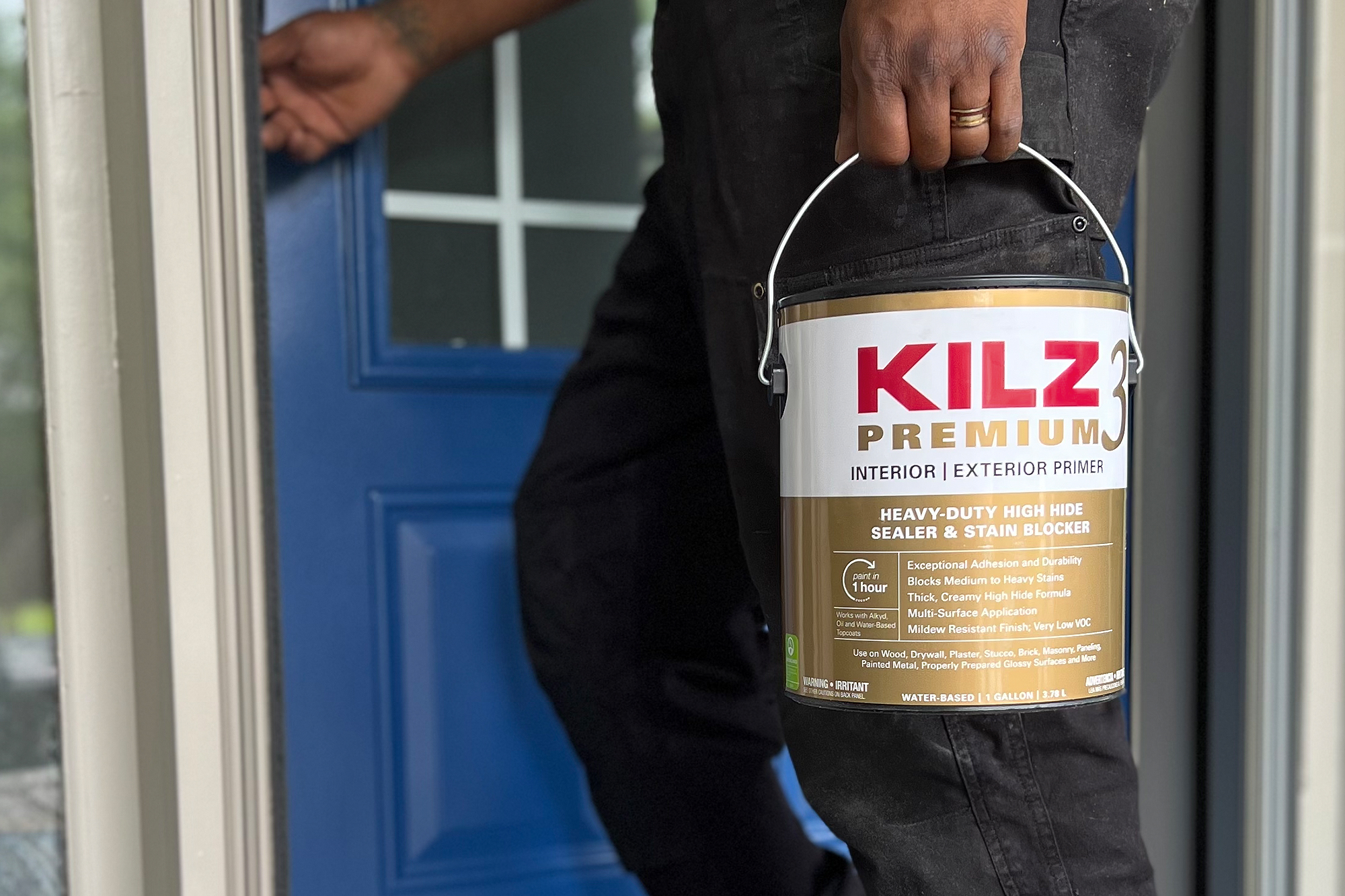
PRO SPOTLIGHT: Make A Front Door Pop with Jared Foster
June 30, 2022With two little ones and running a carpentry business, free time is something that is not easy to come by, so I am always looking for ways to get quality work done more quickly around the house. Being a carpenter, you’d think that my home would always be in tip top shape, but sadly, my personal home is usually the last home I get any work done on. Turns out having two little boys running around means dirt, grime, and messiness can be a pretty normal part of everyday life. But my wife has been wanting to spruce up the front porch area a bit, since this is typically the first part of your home people will see.
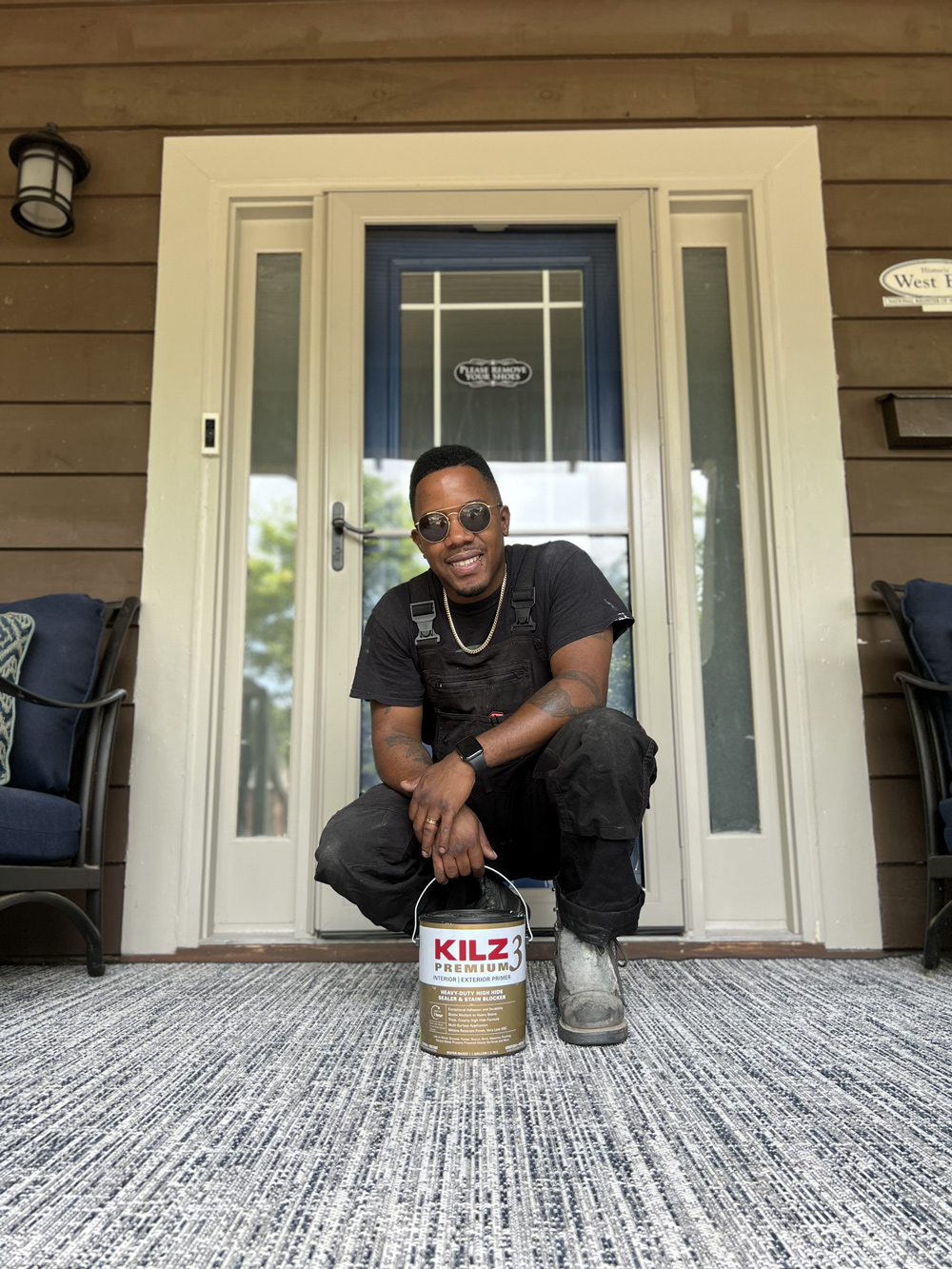
We have this amazing porch swing that I built and we wanted to continue the theme of calm and relaxation as people approached our steps, so we decided to paint the door using Tidal, a navy color from Behr Paint, and Pasha Brown, a brown shade also made by Behr, for the trim. Before any painting got done, we needed to clean and prime the area to ensure the longevity of the paint and look. That’s why we chose KILZ 3® PREMIUM Interior and Exterior Primer. KILZ 3® PREMIUM Interior and Exterior Primer is a superior quality primer that offers excellent adhesion to both the surface and the topcoat. It dries fast, has a low odor and low VOC which makes it a great choice for a primer. The primer includes stain-blocking properties that block most medium-to-heavy stains caused by water, tannin, ink, pencil, felt marker and grease which is essential when you have little ones.
The first step that I needed to take care of was pressure washing the front door and the areas around it to help loosen up and remove the gunk that built up over time. If you’re working with a time crunch, it’s best to utilize some shop rags or towels to soak up the excess water, as this can help speed up the drying process. Otherwise, you can simply let it air dry while you get other things done on your weekend to-do list. After the area dried, I laid down some painter’s paper to get the sanding done with less cleaning up on the backend. Sanding will even out all the old paint and remove any chipped pieces of paint on the door and the trim.
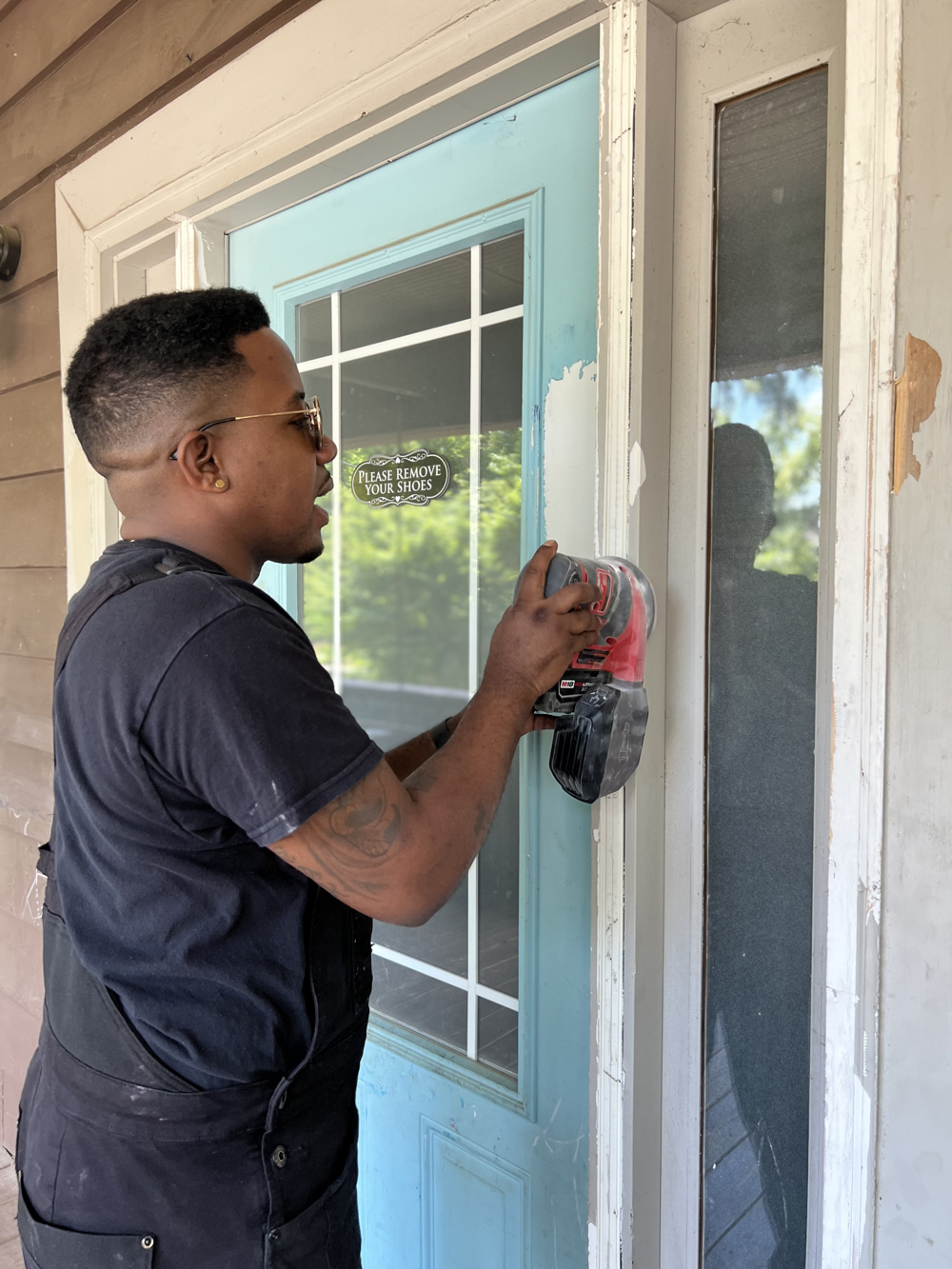
One thing I noticed is that whoever last painted the door to our home, didn’t utilize any primer, as it was really easy for some of the old paint to just peel off in chunks. Priming is a step worth taking, because it can help save time and money in the long run. Living in Atlanta means humid weather and using something like KILZ 3® Premium Interior and Exterior Primer would have helped keep this from happening over time, regardless of the weather conditions. Priming is fundamental for completing any paint project. It is the difference between a job done and a job done right.
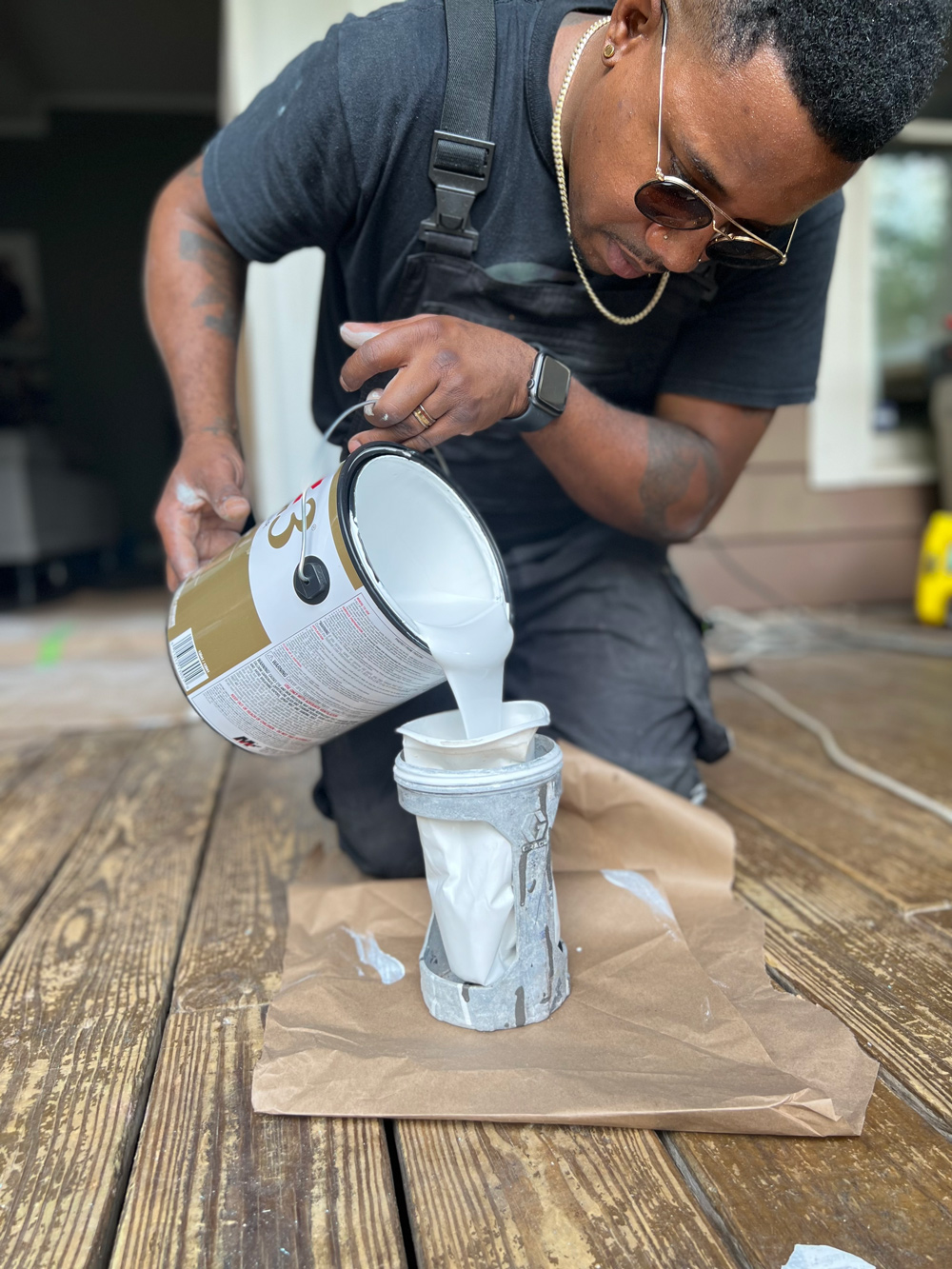
After sanding, I just utilized a leaf blower to get the excess dust off the porch, any extra can just be wiped off. When my son came out onto the porch after his nap, he asked me “daddy, can I help you paint?” One of the aspects of doing projects from home that I enjoy most is being able to have my children join in. It reminds me of the times that I spent learning how to be handy around the house with my pops as a kid. I was able to get my son to help me put down more painter’s tape. This isn’t really a time saving hack, but it’s worth the few extra minutes to let him assist me, as much as a 2-year-old can. We put down more painter’s paper and tape on the trim, door, floor, and walls of the front of the house where we’d be spraying the paint to help save on clean up time.
I chose not to tape off the windows, because if I sprayed anything on the windows I could have quickly used a razor blade to scrape it off once it dried, which would give you a crisp clean finish and save time. Another way to save time would be by removing the door entirely. This would allow you to spray the door separately from the trim and not have to worry about taping anything off again.
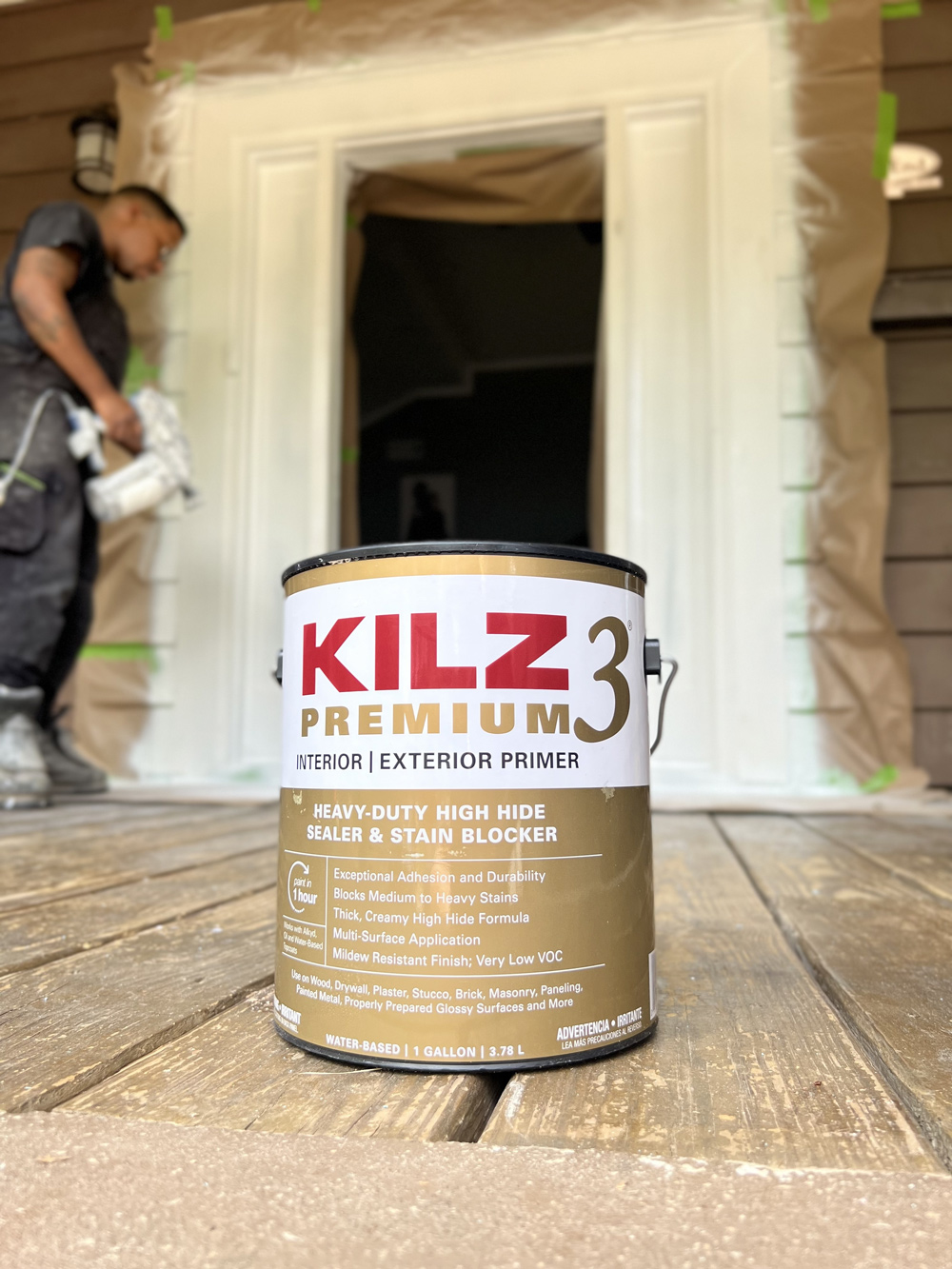
Then it was time to prime the trim and the door. A huge benefit of using KILZ 3® Premium Interior and Exterior Primer is its thicker consistency and high hiding capability which is essential when painting over an existing color and converting from a dark or bold color to a lighter one. KILZ 3® Premium Interior and Exterior Primer is a powerful stain blocker and will block color bleed-through and other stains.
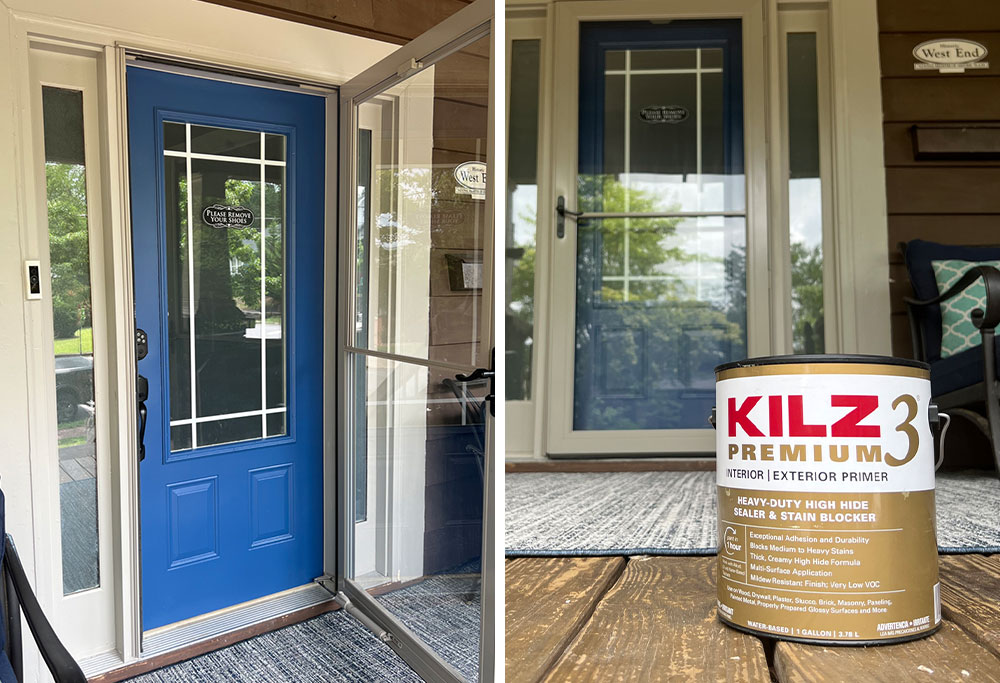
Once I laid on the primer and allowed it to dry, I was able to spray the door and trim using BEHR® paint, remove all the paper and tape and enjoy the new look. All and all, this project was completed in 48 hours and honestly, I was really looking forward to getting it done. Having used KILZ 3® PREMIUM Interior and Exterior Primer I knew this door color would pop, giving me Instagram-worthy photo finishes and people will feel even more welcomed when they visit!
*This is a paid partnership with Jared Foster.
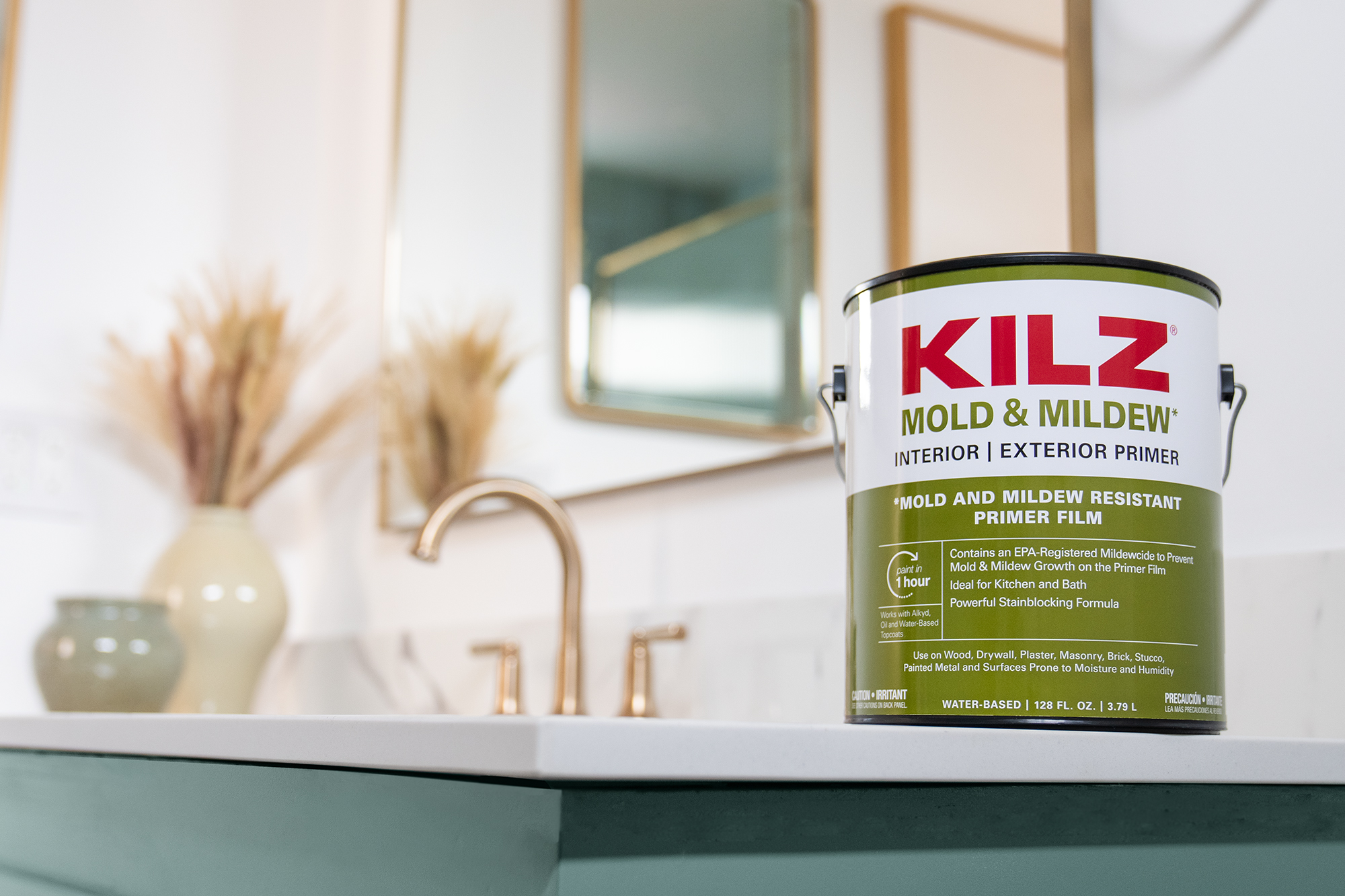
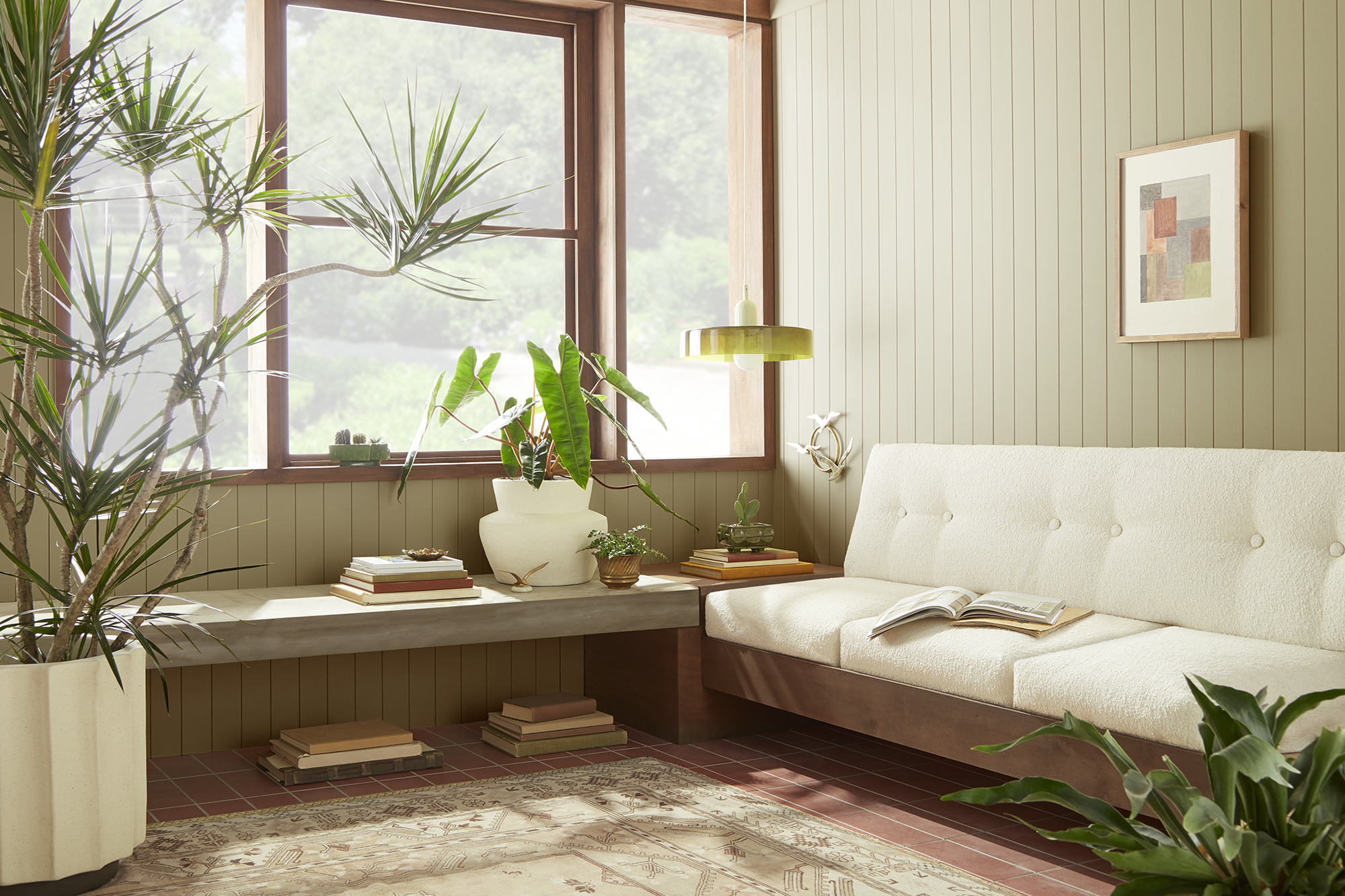

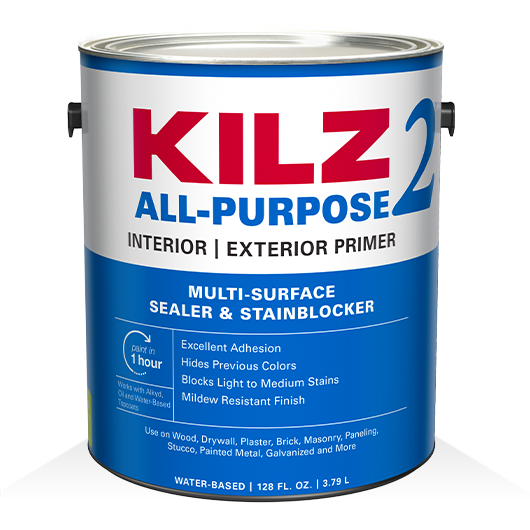
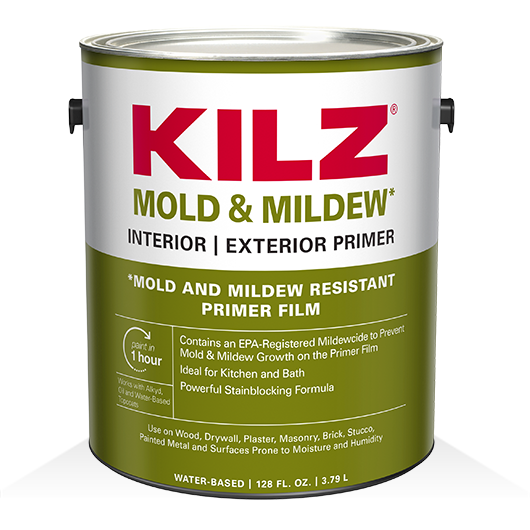
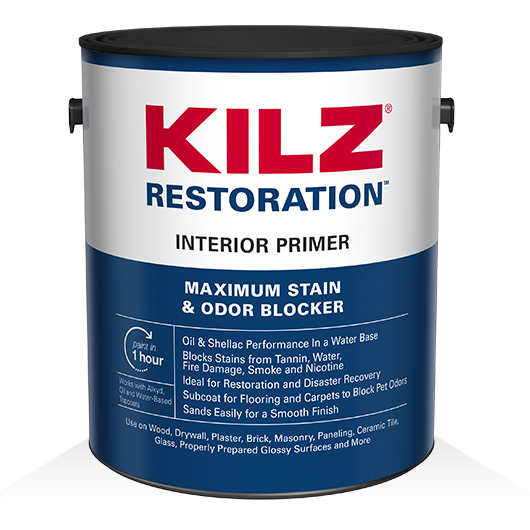


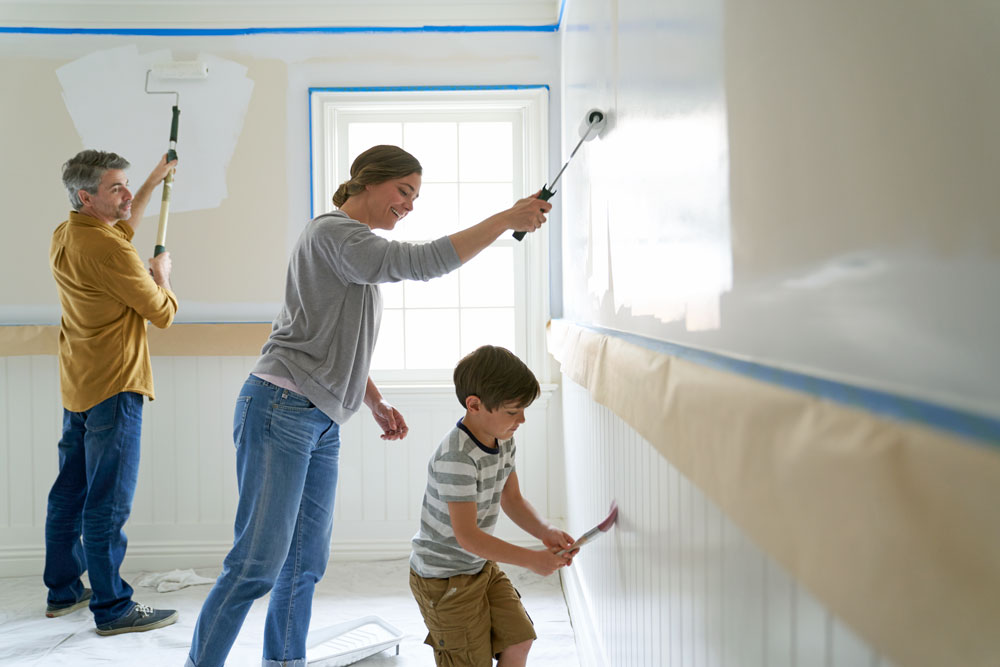
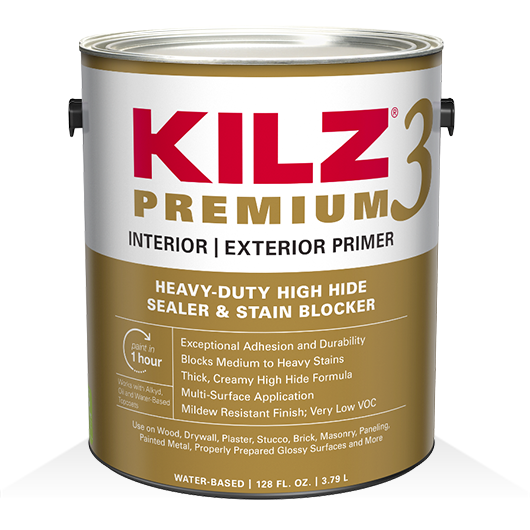
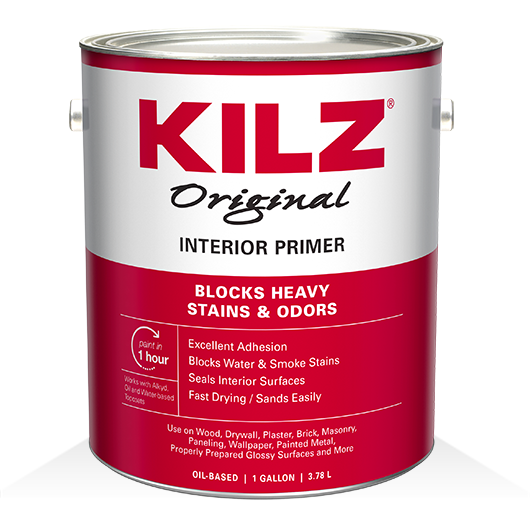

join the conversation:
SHARE this post: